- Dive into advanced Pre-Flop Raise (PFR) strategies to elevate your poker game and gain a competitive edge at the casino table.
- Explore insights from poker statistics and analysis to understand the impact of PFR poker on hand ranges, aggression levels, and overall gameplay dynamics.
- Learn how to adjust your PFR poker range based on position, stack sizes, opponent tendencies, and table dynamics for strategic advantage.
- Implement sophisticated PFR tactics, such as 3-betting and balancing ranges, to exploit opponents and maximize profitability.
- Master the art of PFR poker by combining technical expertise with psychological insights to outplay opponents and achieve consistent success in your games.
Every possible edge in Texas Hold ‘Em can lead to better outcomes and, let’s face it, the fewer opponents you have the better odds you have of winning. One of the advanced strategies in Texas Hold ‘Em is known as the Pre-Flop Raise (PFR).
What is PFR in poker? A PFR Poker strategy is raising the bet before any community cards are revealed (pre-flop). At the beginning, the only money in the pot is from the big blind and small blind. After the hold cards are dealt, the first round of betting begins when players can bet, check, call or raise.
If you’re learning how to play poker and want to consider PFR, this article should prove the basic details to get you started and what to look out for.
Pre-Flop Raise as a Strategy
There are many reasons why PFR can be an important strategy and impacts gameplay in a variety of ways:
- Strong Hole Cards: The community cards can go any number of ways but if you’re holding two strong cards, you can raise before the flop to indicate and scare away potential opponents and/or build the pot.
- Minimize competition: If another player folds, that’s one less person who could potentially find favorable cards in the flop, turn or river. We’ve all been in the position where we fold bad cards only to discover they could have turned into a winning hand.
- Make Them Pay for the Flop: If you have a good hand, don’t let the others see the flop for cheap. Your Pre-Flop Raise indicates your hand is strong and you deserve to play into the next round.
- Collecting Intelligence: If a player folds, they thought their hand was weak. However, if they call or raise, you now have information that they could be holding a strong hand as well.
- Psychological Warfare: If you PFR aggressively, you’re signaling to the others players that you’re not afraid to play and apply some pressure.
What Does the Pre-Flop Raise Percentage Mean?
To determine the PFR percentage, take the number of hands in which a player raises pre-flop versus the number of hands played. If a player raises 15 times out of 100 hands played, the percentage is 15%.
This is used to assess a player’s style and how aggressive or conservative they are and what strategy you can use against it.
Generally, a PFR percentage above 15% indicates they are more aggressive.
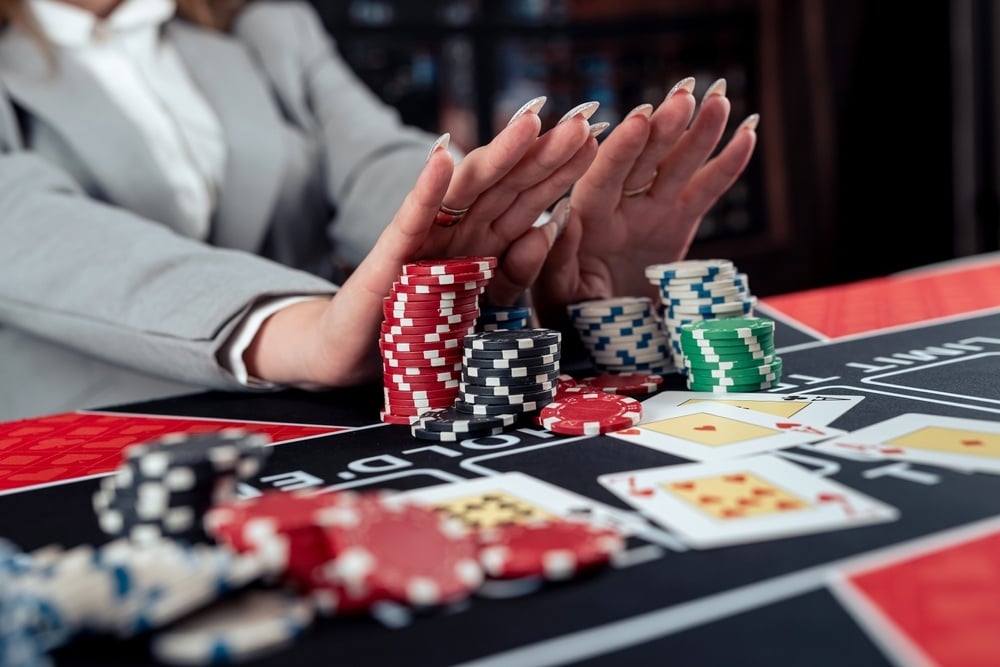
Image credit: RomanR/Shutterstock
What is VPIP?
Voluntary Put money In Pot, or VPIP, is a percentage of how often a player bets, calls or raises. This doesn’t include blinds because those bets aren’t voluntary. An example would be if out of 100 hands played, if you voluntarily put money in 50 times, the VPIP would be 50%.
The Relationship Between VPIP and PFR
The way in which VPIP and PFR are related is in regards to poker strategy and how players bet at the beginning of a hand. While VPIP can happen at any time, PFR obviously can only occur before the flop. However, whether you’re the player raising pre-flop or it’s someone else, it is a key indicator on someone’s betting style.
A player willing to raise pre-flop or has a high Volunteer Put money in Pot percentage plays more aggressively. They are willing to gamble more often, re-raise when prompted and pressure their opponents into calling.
On the opposite side of the spectrum is the player with a lower VPIP and someone more likely to call rather than bet. They tend to play hands more conservatively, which means they’ll play when they have a higher likelihood of winning and less likely to bluff.
Raising pre-flop and monitoring the VPIP of other players can provide you with information about opponents’ hands and force them to call, raise or fold in times they would otherwise make a different decision.
Is PFR higher than VPIP? Generally, no. Players are more likely to put money in voluntarily as the game progresses rather than pre-flop.
PFR Values in Different Poker Formats
Depending on the poker format, there are different values that PFR may have.
- PFR in Six-Max Games are tight-knit with only six players vying for the pot (as opposed to a 9-10 player format). Because this is a smaller game, the players tend to be aggressive. There is a tendency for more action and the game moves quicker. Players have a PFR percentage closer to 20-30% with the more conservative players still raising pre-flop around 15% of the time.
- PFR in Full Ring Games are played with more traditional PFR percentages because there are 9-10 players. Unlike in the six-man games, the aggressive players in full ring games have a PFR percentage closer to 15%. The more conservative players will raise pre-flop only about 5-8% of the time.
- PFR in Zoom Poker Games is fast-moving, as the name suggests, which means players who want to stay in will PFR aggressively. In a game in which if you fold, you get moved to a new table, there is a greater incentive to stick around and learn your opponents’ strategies. The most aggressive players can have a PFR percentage close to 30%. The likelihood of moving frequently means you have to change your strategy all the time.
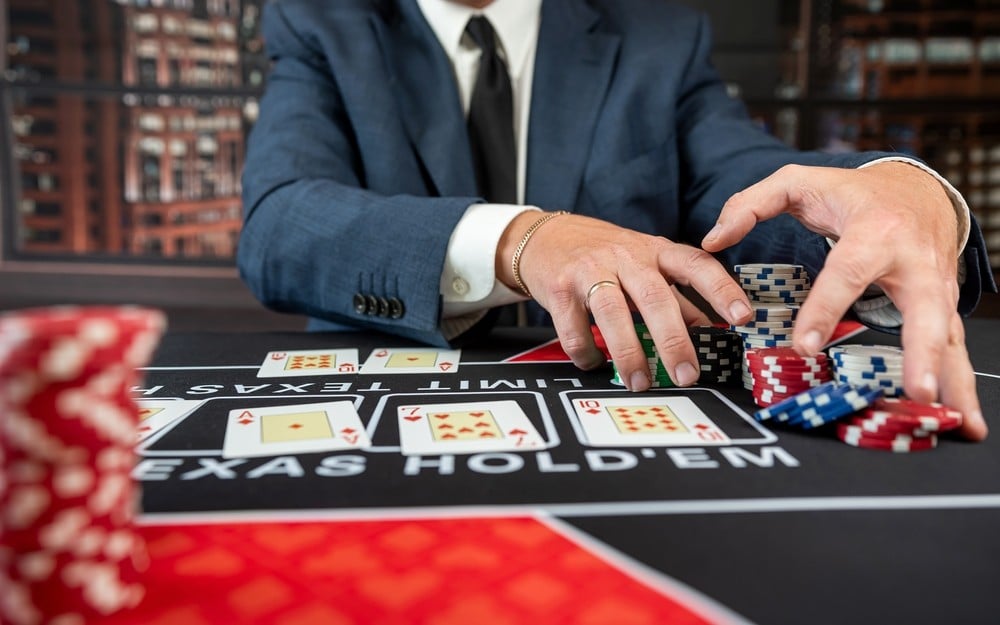
Image credit: RomanR/Shutterstock
Exploiting Opponents Using PFR
If you can identify different player types with PFR while playing Texas Hold ‘Em, you’ll be better prepared to challenge your opponents and have an edge with your hand.
4 Types of PFR Players
Although these percentages will vary depending on whether you’re playing a Six-Man Game, Full-Ring Game or Zoom Game, the types of PFR player remains the same. For context, the below percentages are based on a Full-Ring Game.
- Aggressive Players play just like that: aggressively. They will have a PFR range between 12-20%, so it’s likely they will raise pre-flop in 1 out of 5 games. An aggressive players’ strategy puts pressure on the others and often forces them to either fold (reducing the number of opponents) or call (which raises the poker equity). Aggressive players tend to play when they have a perceived strong hand.
- Tight-Aggressive Players tend to PFR selectively. Most of the time they’ll do it because they have a strong hand. They’ll occasionally bluff and hope to make a hand in the community cards, or force the others to fold. ?Tight-aggressive players have a PFR between 8-12%.
- Tight-Passive Players will typically raise pre-flop if they have a good hand so they have a lower PFR percentage at around 5-8%.
- Loose Players are similar to aggressive players in that they have a high PFR percentage. The difference is that a loose player’s strategy is about playing more hands and being somewhat unpredictable. Loose players will PFR even if they don’t have a great hand and have a high PFR percentage range of 15-20%, sometimes more.
So, how do you combat these varying PFR players? You can adjust the way you play by reading other players at the table to throw them off-balance. If a player is aggressive and calling or raising, get more selective in when you call or raise and ignore the pressure to raise or call.
If the players are more passive, consider raising with more frequency. This applies pressure on your opponents to call or raise, which increases the pot size, or will make them fold so you can take more blinds.
What is a good VPIP and PFR?
A good VPIP and PFR can be dependent on how a player chooses to play poker.
- High VPIP and Low PFR: This type of player tends to call rather than raise unless they have a big hand. They likely won’t bluff and will play the cards, not their opponent.
- Low VPIP and Low PFR: This type of player only plays big if they have a big hand. They don’t mind folding and rarely play big.
- Medium VPIP and Low PFR: A medium VPIP means putting money in about a quarter of the time. They’re more likely a casual player who calls a lot of raises and won’t bet big unless they have a good hand. When they bet, assume they have a decent hand.
- Medium VPIP and Medium PFR: This is the ideal strategy. If you’re not used to playing this way, ease yourself into it. It’s not easy playing a possible junk hand to outwit your opponents.
Common Mistakes to Avoid
- Over-raising. With a high PFR percentage, you’re opening yourself to other aggressive players who might have better hands once the community cards are dealt. It’s okay to be aggressive, but consider your PFR percentage.
- Raising to see the cards. If you Pre-Flop Raise or call to see the flop cards, you might be delaying the inevitable. There’s no point in losing chips just to see how things play out in the flop.
- Failure to adjust. Poker is all about reading the other players. If you notice you’re at a table with aggressive players, failing to adjust is setting yourself up to make mistakes.
- Playing based on potential. If you overvalue your hand and PFR on the possibilities, you’re playing with hope and not strategy. Learning the difference between exploitative play and GTO play is important in maintaining balance in your game.
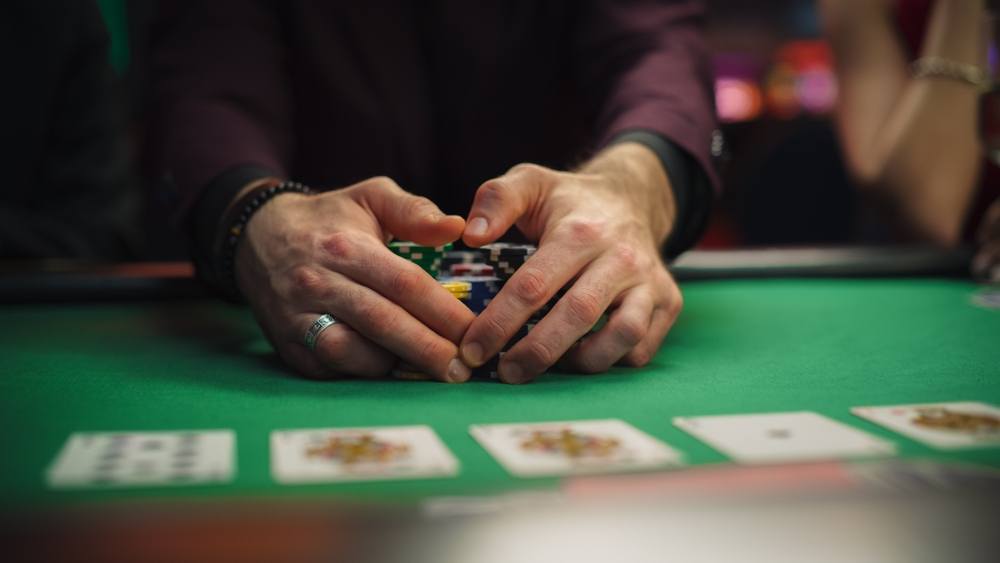
Image credit: Kitreel/Shutterstock
PFR Poker Strategy
- There are many reasons why PFR can be an important strategy and impacts gameplay in a variety of ways. It can help increase the pot, make others fold or be an aggressive move with strong hold cards, to name a few.
- Consider both PFR and VPIP, which is the percentage a player voluntarily puts money in the pot. Both provide insight into a player’s strategy.
- Depending on the poker format, a player may change their strategy.
- There are generally four types of PFR players: Aggressive, Tight Aggressive, Tight Passive and Loose players.
There are many guides that can help players continue their poker education and no shortage of articles like this one that provide insights into overlooked strategies and information to take to the poker table.
One of the best ways to learn is to jump into it. If you’re a regular at a casino, live dealer poker or online poker game, start paying more attention to PFR and VPIP and consider how to take advantage of the players and their preferred methods of play.
]]>- Develop a solid foundation in casino card counting to enhance your blackjack strategy by learning how to mentally track the ratio of high and low cards remaining in the deck.
- Explore various card counting systems, such as the popular Hi-Lo or the MIT methods, to determine which approach aligns best with your skill level and playing preferences.
- Hone your card counting proficiency through dedicated practice sessions that include drills and simulations using free online blackjack designed to simulate real blackjack scenarios.
- Implement effective card counting strategies during gameplay by maintaining focus, staying attentive to the cards being dealt, and making calculated decisions based on your counting system’s signals.
- Enhance your overall blackjack strategy by combining card counting with fundamental playing strategies, such as basic strategy charts.
A key to unlocking constant blackjack wins, a hockey system not worth trying, or just plain cheating? There is no doubt that card counting divides opinion, and there are a lot of myths around this technique. But exactly how do you count cards in blackjack?
On this page, we will break down those myths to bring you the truth about counting cards. Learn how to count cards and understand how this strategy can boost your blackjack gameplay.
How to Count Cards in Blackjack
Card counting in blackjack is a technique that can give the player an advantage by tracking high and low-value cards during a game. When you know how to count cards in blackjack, you essentially have a mental map of which cards have already been used and which remain. At its core, blackjack card counting gives players an extra advantage against the casino’s house edge.
Why Learn Card Counting?
Blackjack is a game of luck, even if it does have elements of skill. However, if you become good enough at counting cards, the game becomes beatable. Sounds great, but what’s the catch? Well, blackjack card counting is incredibly difficult and requires a lot of training and skill, and even then, you may not be able to do it.
Knowing how to count cards in blackjack allows you to control your betting based on which cards you perceive as remaining. It is a deceiving system because the logic of card counting is easy to understand, but doing it in practice is very difficult.
All card counting starts with assigning cards with a zero, positive, and negative value, all of which contribute to the Effect of Removal (EOR). As the name suggests, this provides an estimate of what impact removing a specific card will have on the house edge.
Legality of Card Counting
One of the most interesting things about card counting is that it is not illegal. In the US, no law says you cannot count cards when playing blackjack. Other countries view it similarly, making it technically “legal” around the world. It is interesting that counting cards is not cheating, as you are not unfairly influencing the outcome of the game.
Even so, you are not going to be greeted with open arms by land-based casinos if they know you are card counting. In fact, you are likely to be thrown out if the casinos suspect you are counting. You’re free to try, but most casinos frown upon it and will ban you if you are caught.
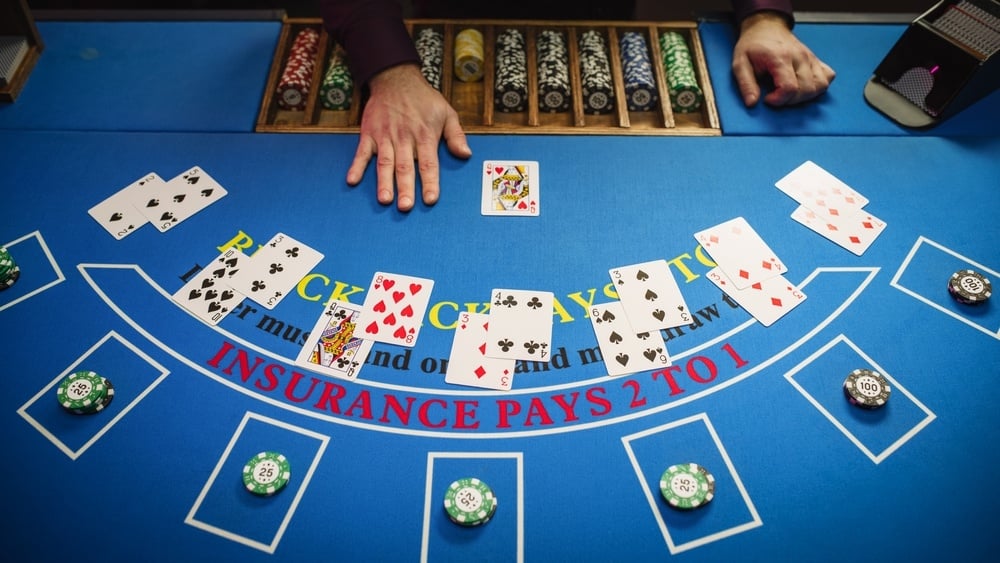
Image credit: Kitreel/Shutterstock
Basic Concepts of Card Counting
The fundamental knowledge you need to start card counting is understanding the card values in blackjack. If you are unfamiliar with blackjack, it is a casino card game where you play against the dealer. The objective is to get closer to 21 than the dealer without going over. You get two initial cards and can “Stand” with those two or “Hit” to receive more cards.
Each card in blackjack has a value that you add together to get a hand total. For numbers 2 through 10, the value is the number. Picture cards all have a value of 10, while the Ace counts either as 11 or 1:
| Card | Value |
| 2 | 2 |
| 3 | 3 |
| 4 | 4 |
| 5 | 5 |
| 6 | 6 |
| 7 | 7 |
| 8 | 8 |
| 9 | 9 |
| 10 | 10 |
| Jack | 10 |
| Queen | 10 |
| King | 10 |
| Ace | 1 or 11 |
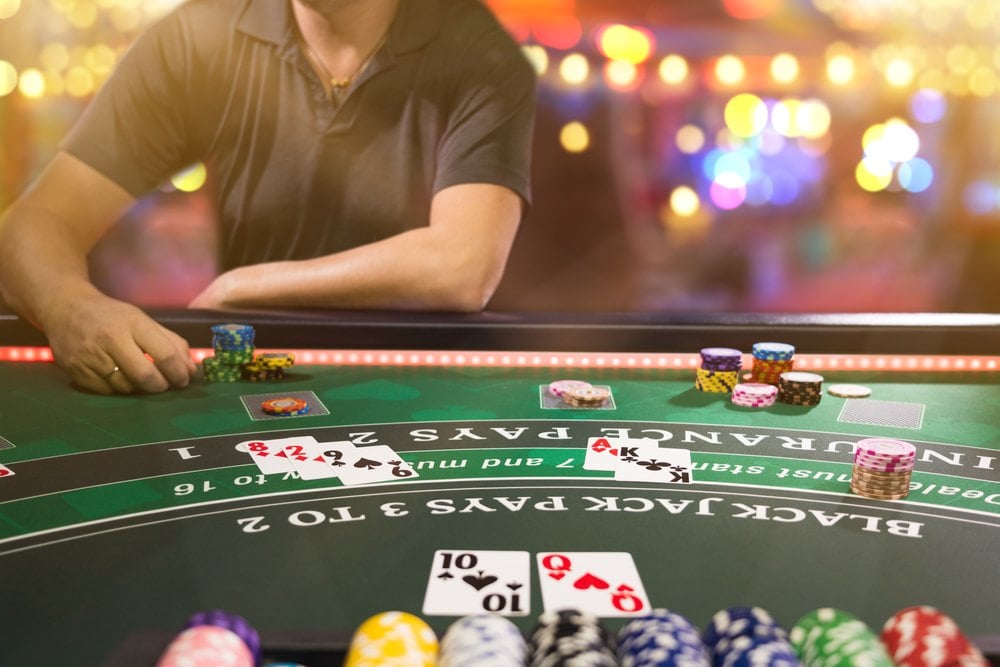
Image credit: Netfalls Remy Musser/Shutterstock
Understanding the Deck
Most blackjack games use more than one deck, which is partially a response to card counting. If you do play a single-deck variant, counting cards is relatively easy as you only track 52 cards. In more common multi-deck games, you need to track more cards, which is why counting cards requires an excellent memory.
Each card in the deck is given a positive, negative, or zero value by the card counter. Which value is given depends on the card, so let’s expand on the table above to see the -/+ values for blackjack card counting:
| Card | Value | + or – value |
| 2 | 2 | +1 |
| 3 | 3 | +1 |
| 4 | 4 | +1 |
| 5 | 5 | +1 |
| 6 | 6 | +1 |
| 7 | 7 | 0 |
| 8 | 8 | 0 |
| 9 | 9 | 0 |
| 10 | 10 | -1 |
| Jack | 10 | -1 |
| Queen | 10 | -1 |
| King | 10 | -1 |
| Ace | 1 or 11 | -1 |
The Running Count Vs. The True Count
To track cards properly across multiple decks, counters use a running count and a true count. Both of these are important components when you learn how to count cards:
- Running Count: At the core of card counting is the running count, which is the total value of all cards that have been dealt. So, if a 2, 5, King, and 8 are dealt, the running total for the sequence would be +1 (+1, +1, 0, -1 = +1). This is known as the running count, and if it remains positive, it means there are more high cards left in the decks. If it is negative, there are fewer high-value cards.
- True Count: You can now find the true count by taking the running count and spreading it across all decks in the game. The running count only shows the one deck in play at that time, while the true count adjusts the number for all remaining decks. This is done by dividing the running count by the number of decks left.
Step-by-Step Guide to Counting Cards
Knowing how to count cards in blackjack adds an extra element of skill to help you control your betting during a game. Simple in concept but harder in practice, let’s apply what we know so far into a clear gameplay flow.
- Give each card a value. You can choose your own values, but we recommend beginners stick to the traditional card counting valuations (2-6 is +1, 6-9 is 0, 10-Ace is -1). The dealer will now deal cards, and your goal is to adjust your count on each card. There is a constant Effect of Removal (EOR) for each card dealt that dictates if you bet higher or lower.
- Maintain your running count and adjust it on each card dealt. If you learn your values well, you will only need to keep the total count in your mind and not memorize each card. A positive running count means you are gaining an advantage because more cards with a higher value remain. The negative count means you are losing your advantage.
- At intervals in the game, divide the running count by the number of decks to find the true count. Once you know the true count, you have a much better understanding of how well you are doing. If your advantage is significant, you can increase your bets. If you are losing your advantage, consider lowering bets or stopping play completely.
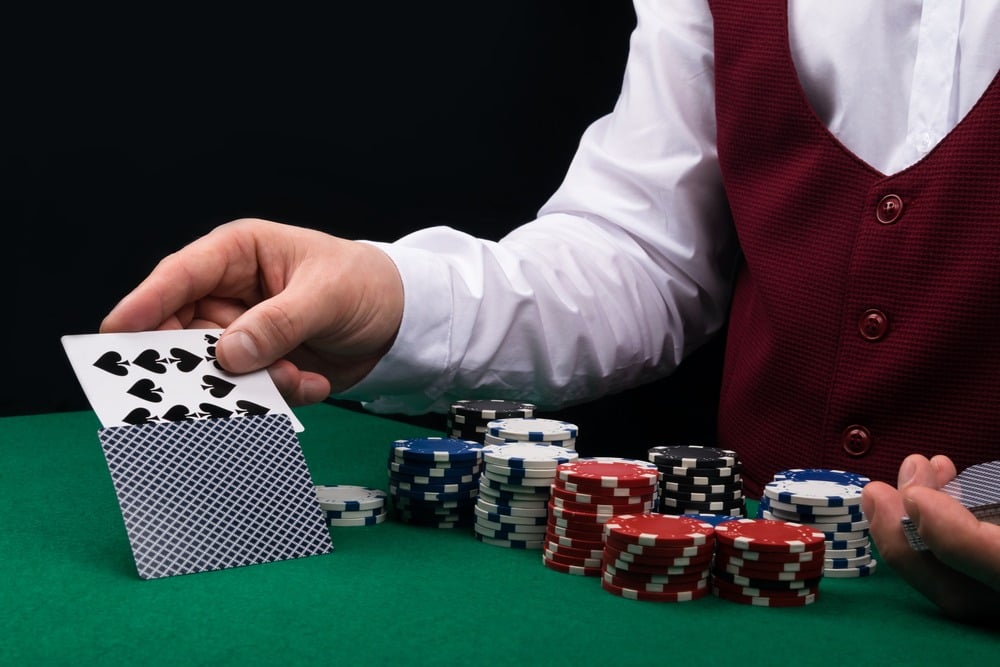
Image credit: Aleksey Kurguzov/Shutterstock
Tips for Beginner Card Counters
We bet you are surprised by how simple card counting actually is. Even so, it does require you to spend time properly understanding how it works. Below are some tips and resources to help you master counting cards in blackjack more quickly.
- Practice Makes Perfect: Nothing beats repetition, so the more you try card counting, the more efficient and accurate you will become. You can practice at home using your own decks of cards and simulating a game. You can also find online apps that offer automated simulations to learn card counting, while there are also books you can read to learn about different methods and techniques.
- Master Basic Strategy: Basic blackjack strategy charts show you whether to Hit, Stand, Split, or Double on specific hand totals. For example, should you Hit or Stand if you have a 6 + 8 in your hand? Basic strategy helps you make the best gameplay decisions and is something all players should know. Combining it with card counting makes for a potent combination of safe decision-making based on statistical knowledge.
- Learn It All: Before applying any card counting, you will need to study. Firstly, learn how to play blackjack and all card values and gameplay options. Next, make sure you properly understand what card counting is and how it works.
- Manage Your Bankroll: It is easy to sometimes get into a trap of feeling invincible when you are counting cards. While this method can give you a lot of insight and control, counting cards does not guarantee wins. Do not chase losses and manage your budget by only using money you can afford to lose.
- Online Card Counting: Thinking about bringing your newfound counting skills to online blackjack? That may not be possible because virtual blackjack games use random number generators, which means there are no set cards of decks – it’s all random. Live online casino games do use real cards/decks, but they are constantly being shuffled.
Advanced Card Counting Strategies
Once you know how to count cards and are confident, you may want to expand your repertoire into more advanced techniques:
Back Counting
Back counting is an alternative system where instead of counting all cards, you only focus on the cards dealt face-up. It is easier to learn, and you can apply it by following the steps below:
- Focus on face-up cards: Only track the cards that the casino deals face-up to you and the dealer.
- Track high and low cards: Track the face-up cards, keeping a simple count of the high-value (10, Jack, Queen, King, Ace) and low-value cards (2-9) that have been dealt.
- Adjust your bets: If more high cards have been dealt, lower your bets as your chances of a good hand are decreasing. If there are still more high cards left in the decks, consider increasing your wager as you have more chance of a good hand.
Modified Card Counting Strategies
Modified card counting strategies are different methods for card counting that focus on solving unique problems in the standard technique. For example, modifications could be adjusting card values or betting guidance. Let’s take a look at some examples of modified counting strategies:
- Simplified systems: This methodology focuses on reducing the number of cards you need to track, such as the Back Counting system above. The Ace/Five method is another example.
- Balanced systems: Balanced card counting attempts to reduce fluctuations in your bankroll. Instead of big bet value swings, you make more incremental bet adjustments. Try the Omega II method for a balanced counting system.
- Insurance-based systems: Some systems may introduce insurance bets into card counting strategies.
- Multi-deck systems: While standard card counting accounts for multiple decks, there are systems that put more focus on this challenge. The Knock-Out Count method is a notable example.
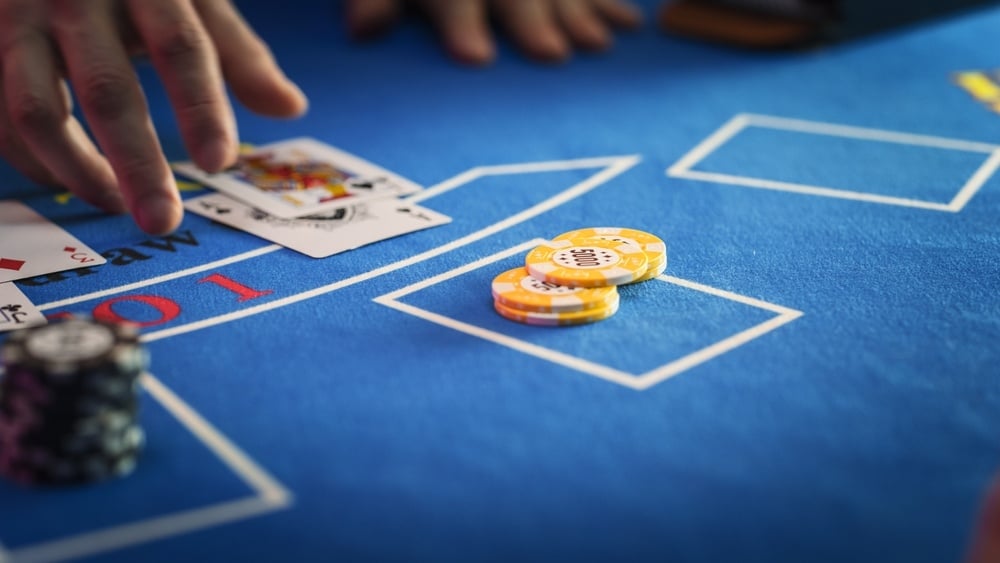
Image credit: Kitreel/Shutterstock
FAQs About Card Counting in Blackjack
- Does counting cards in blackjack work?
Yes, but only to an extent. If you master basic card counting, you definitely gain more knowledge about what cards are in play and can adjust your bets accordingly. However, you never control the next card dealt, so blackjack remains a game of luck, and you cannot directly influence the outcome of your hand.
- Is counting cards in blackjack illegal?
It is not a criminal offense to count cards, as all you are doing is keeping track of cards that have been dealt. In fact, it is not even cheating because you are not unfairly trying to trick the game to win. Even so, most casinos do not like card counting – they will dismiss you if you are caught and potentially ban you from returning.
- What is the formula for counting cards in blackjack?
In blackjack card counting, each card is given a positive, negative, or equal value and you tally up the value based on each card that has been dealt. You then divide the “running count” by the number of decks in play to find the true count. This allows you to assess your chances of winning and adjust your bets accordingly.
]]>- Dive into mastering blackjack by understanding key rules and embracing fundamental strategies that lay the foundation for a successful gaming experience.
- Elevate your casino gameplay to a higher level by delving into the world of card counting techniques, a skill that seasoned players utilize to gain a statistical edge over the casino.
- Harness the power of effective bankroll management strategies to ensure that your gaming funds are strategically allocated and safeguarded against unnecessary risks.
- Explore the realm of advanced betting systems such as the Martingale or Paroli strategies to fine-tune your wagering approach and capitalize on favorable streaks at the blackjack table.
- Continuously refine your blackjack skills through deliberate practice with free blackjack games, ongoing study, and adaptive gameplay strategies that evolve with your experience and insights gained from previous sessions.
Blackjack is a unique and exciting casino game that involves both skill and luck. It’s a simple game to learn, but one that requires studying and practice to master.
With that in mind, if you’re looking for proven tips and strategies on how to increase your chances of winning in blackjack, you’ve come to the right place!
This article will overview everything from basic blackjack tips to advanced strategies, money management techniques, and more. Read on to learn how to boost your success at the blackjack table.
Essential Blackjack Tips for Beginners
Before you start playing blackjack for real money, it’s essential to understand all of the basic blackjack rules. The objective of the game is to get as close to 21 without going over it and have a higher-valued total than the dealer. To do so, you have to decide when you want to hit, stand, double down, split, or exercise any of the other blackjack side bets.
Regarding basic strategy tips, there are several considerations that you should keep in mind to be a better blackjack player. Here are a few essential blackjack tips for beginners:
- Always stand on a hard 17 or higher
- Always stand on a total of 12 to 16 if the dealer’s upcard is 2-6
- Double down on an 11 hand
- Always split Aces and 8s
- Never split 10s and 5s
If you’re playing blackjack in a live casino venue, it’s also good to learn the hand signals, as this will ensure a smoother and more immersive gambling experience. There are a handful of blackjack hand signals, so we’ll briefly cover each of them below:
- Hit – If you want to add another card to your total, gently tap the table in front of you to signal the dealer that you want to hit.
- Stand – If you’re content with your hand total and want to stand, wave your hand over your cards to signal to the dealer that you don’t want any additional cards.
- Double Down – To double down, match your initial wager with the same amount of chips next to it and hold one finger up.
- Split – If you want to split a pair, you place an additional bet matching your original wager and make a V-shape with two fingers next to your cards without touching them.
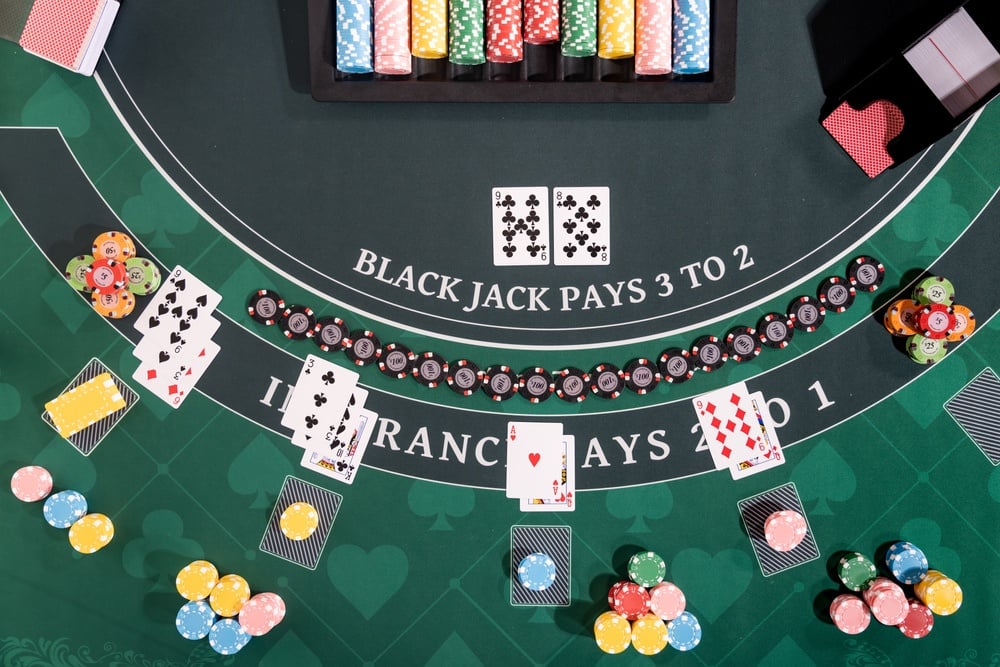
Image credit: Netfalls Remy Musser/Shutterstock
Advanced Blackjack Strategies
When you’ve mastered the basic blackjack tips we’ve covered above, you can confidently move to more advanced strategies. In this regard, here are a few advanced tips for playing blackjack.
Using the Basic Strategy Chart
Blackjack is a decision-driven game, so every choice you make directly impacts your success in it. Luckily, the blackjack pros who have come before us have already outlined the optimal ways of playing the game. The best way to play blackjack is to use the optimal strategy chart that helps you make the right decision in every scenario.
A basic blackjack strategy chart considers your cards and the dealer’s upcard to instruct you when to hit, stand, split, double, or surrender. Of course, even this chart can’t guarantee a win every time. But, it can statistically give your hand the best winning chances.
Learning to read a blackjack chart is fairly straightforward, and you can even bring it to the casino. Moreover, many land-based venues even sell these helpful charts in-house. With this in mind, make sure to use the right chart for the blackjack variation you’re playing and never deviate from the basic strategy.
If you’re playing online, you can even play free blackjack in demo mode. This is a great way to practice using the basic strategy chart before you start playing with real money.
Mastering Card Counting
Card counting is arguably the most appreciated advantage technique among blackjack players. And for good reason. With optimal play and a well-practiced card-counting system, you can get approximately a 1% advantage over the casino, on average.
If you’re a beginner, mastering card counting can be challenging, but it’s still possible to master simple and effective card-counting systems like Hi-Lo with some practice. With that said, while card counting is a viable technique to obtain the edge, you should be aware that casinos frown upon this, and it doesn’t work in online games.
Understanding the True Count and Its Impact
Since nearly all casinos use six to eight blackjack decks for their games, counting cards is more complex than it used to be for single-deck blackjack. Primarily, to successfully count cards, you also need to understand the true count and how it affects the blackjack house edge.
In simplest terms, the true count represents the average ratio of high to low cards remaining per deck. For instance, let’s say that the true count is +2. This means that there are two more high cards per deck than low cards, giving you a slight advantage over the casino.
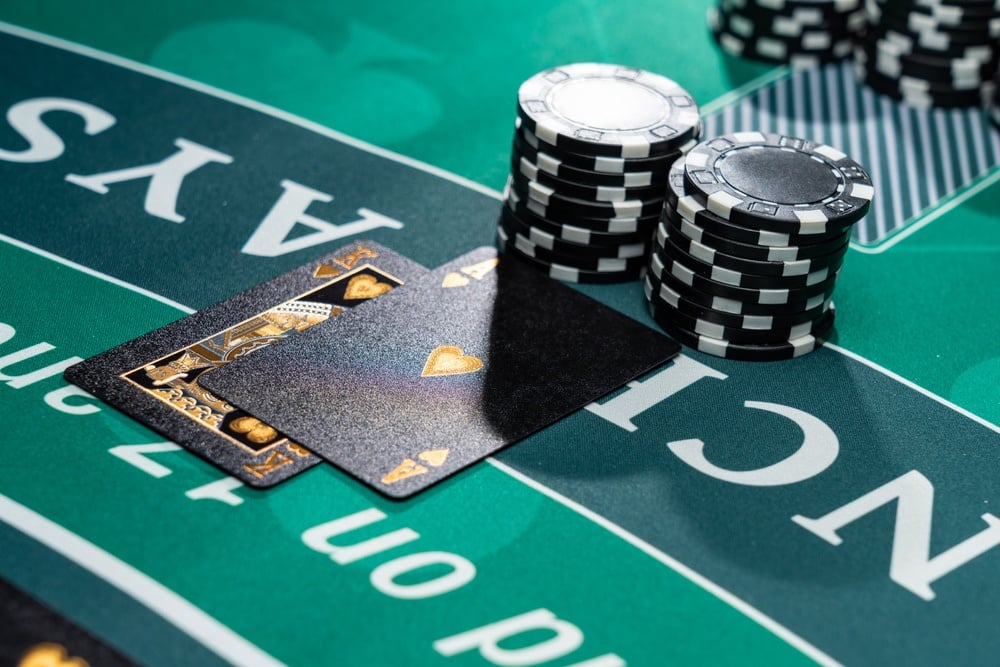
Image credit: Netfalls Remy Musser/Shutterstock
Blackjack Tips: Money Management Techniques
Apart from understanding basic and advanced blackjack strategies, knowing how to manage your money is a vital part of being successful when playing blackjack. So, to make sure you have this aspect covered as well, we’ve prepared a few helpful money management tips.
Setting a Budget and Sticking to It
Setting a blackjack bankroll is the most important part of proper money management. This bankroll should only be up to the maximum amount you can afford to lose without experiencing any financial strain.
Set a total bankroll and a session bankroll that you’ll take with you for individual gambling sessions. Creating these clear financial guidelines will enable you to enjoy your blackjack sessions without worrying about losing too much money or feeling the urge to chase losses.
Managing Wins and Losses
No matter how skilled you become at blackjack, the game still involves a significant degree of luck. This means that wins and losses are two inseparable parts of the game, and you’re bound to experience both. The key is knowing how to manage these highs and lows without letting them affect your bankroll.
The best way to manage wins and losses is to always have a long-term focus and set realistic goals you can target. Don’t let emotions guide your bets when experiencing hot and cold streaks. Always play with a clear head. Don’t allow winning streaks to make you overconfident and reckless. In the same breath, don’t get disheartened by losses and bet when you’re not composed.
Using Betting Systems Wisely
Blackjack betting systems can be a great way to ensure a systematic approach to wagering and aid in bankroll control. That is if you pick the right betting system for your bankroll and betting preferences.
There are many different betting systems you can choose from like Martingale, Fibonacci, Paroli, and others. Make sure you pick a betting system that works for you and use it wisely, but remember that even this methodical strategy won’t guarantee you wins.
Blackjack Tips: Common Blackjack Mistakes to Avoid
Since blackjack involves a skill element, it’s also possible to make mistakes that can cost you money and hinder your long-term success. Here are the most common ones beginner blackjack players make:
- Missplaying Soft Hands – Soft hands are less likely to bust out, which causes many players, especially beginners, to often play them more recklessly. In this regard, while soft hands provide more freedom in decision-making, be careful not to misplay them and always stick to the basic blackjack strategy.
- Ignoring Table Rules and Conditions – Playing blackjack without a complete understanding of all the rules and conditions increases your chances of making mistakes. If you’re playing online, rules are most often transparently outlined in the game info. If you’re playing in a brick-and-mortar venue, don’t hesitate to ask the dealer to explain any rule or condition you’re unsure about.
- Over-betting and Chasing Losses – When over-betting, you’re needlessly straining your blackjack bankroll by placing larger wagers than you can afford. Moreover, if this leads to a bad run and your bankroll drains quickly, you might feel the need to chase losses. Both of these common mistakes will most often result in money loss, so you should be mindful of them and try to avoid making them.
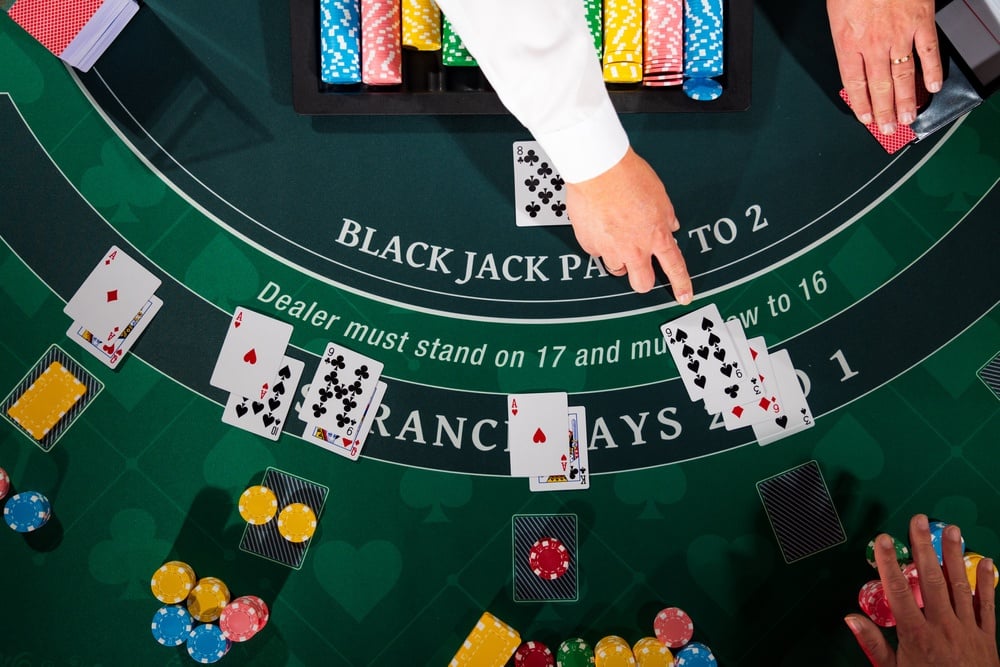
Image credit: Netfalls Remy Musser/Shutterstock
Blackjack Tips: Blackjack Etiquette and Best Practices
In addition to knowing helpful blackjack tips and tricks, it’s also good to know some basic etiquette and best practices you should be mindful of when at the blackjack table.
If you’re mainly playing online blackjack, you can apply some of these tips, but they primarily pertain to live casino blackjack games in brick-and-mortar venues.
Interacting with the Dealer and Other Players
Blackjack falls in the middle of the road when comparing the social aspect of casino games. It’s not as social as craps, but there is still some social aspect and interaction between participants.
With that in mind, you shouldn’t feel obligated to engage in small talk with the dealer or other players if you want to be silent and play. On the other hand, it’s completely normal to chat with others and have gambling and non-gambling conversations if they’re interested in engaging with you in this way.
Tips on Tipping
In land-based casinos, especially in the US, it’s customary to tip the dealer when you win. If you’re playing at the lowest stakes, it’s understandable not to tip, as any tip could have a noticeable impact on your EV. That said, even for bets of $5 or $10 per hand, tipping a couple of bucks after a few consecutive wins is common practice.
For players wagering at $20 minimum bet blackjack tables or higher, a customary tip is $5 to $10 or a percentage of a win. When it comes to the latter, this can be anywhere from two to five percent.
Maintaining Composure
Maintaining your composure is one of the most important pieces of blackjack etiquette, particularly when you’re playing in a land-based casino. Understanding and controlling your emotions is essential, as failing to do so can negatively affect your session and ruin the gambling experience for others at the table.
Always be courteous and respectful toward the dealer and other players. Even if you’re experiencing a losing streak, try to stay calm and not let this cause you to act impolitely or unpleasantly toward others.
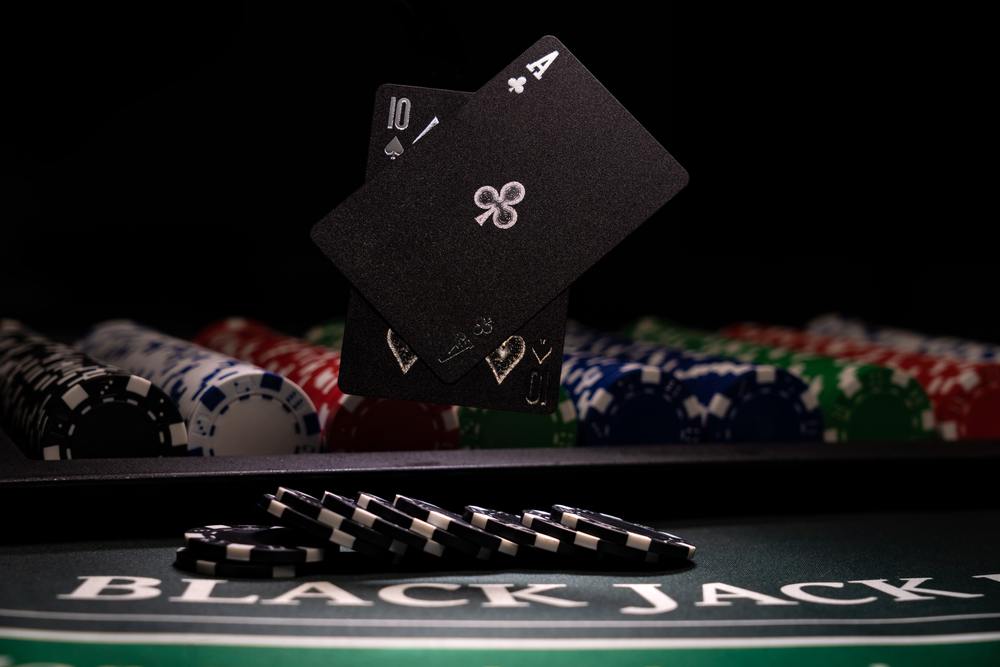
Image credit: Netfalls Remy Musser/Shutterstock
Blackjack Tips: Answering Popular Blackjack Questions
What is the Best Strategy for Blackjack?
The best blackjack strategy is outlined in a blackjack chart, which tells you exactly what move to make based on your card total and the dealer’s upcard. A blackjack strategy chart will help you make the optimal decision every time, and you can even use it when playing blackjack in land-based casinos.
How to Consistently Win at Blackjack?
If you’re looking for tips on how to win blackjack every time, it’s essential to know that there’s no way to guarantee winning when playing this card game. That said, to maximize your long-term winning chances, make sure you understand the fundamentals, practice with free blackjack, use a blackjack chart, and manage your bankroll carefully.
Is There Any Trick to Blackjack?
Blackjack is a very straightforward game, although there are a few tips you can keep in mind to play it more proficiently. Some of the basics include always standing when your hand is 12-16 and the dealer is showing 2-6. Additionally, you should always split Aces and 8s and never split 10s and 5s.
What is the 777 Rule in Blackjack?
The 777 rule in Blazing 7s Blackjack is that you win if one of your first two cards is a 7. Additionally, the payout is more generous if both of your cards are 7s and if the dealer is also showing a 7 as their upcard.
]]>- A flush draw in online poker is when a player has four cards of the same suit and needs just one more of that suit to complete a flush.
- Recognizing a flush draw is critical as it can potentially lead to a strong poker hand if the fifth card of the same suit is dealt.
- There are two main types of flush draws: the “nut flush draw,” which includes the Ace of the suit, and the “non-nut flush draw,” which does not.
- Deciding when to bet, call, or fold in a flush draw scenario depends on several factors, such as table position, pot odds, and your read on other players.
- A flush draw strategy is a dynamic part of casino poker gameplay that requires careful assessment of risk and reward, adding an extra layer of excitement to the game.
When I used to teach beginner’s poker classes, I liked to kick-off by asking if anyone had already played poker before. A handful of people would raise their hands.
“Keep your hand up,” I’d say, “if you’ve ever heard of a royal flush.”
Everyone’s hand would remain up in the air.
“Now keep your hand up if you’ve ever hit a royal flush,” I’d ask them — and inevitably, almost everyone’s hand would drop straight down. The answer was nearly no one.
So why are we talking about ‘royal flushes’ in an article that is supposed to teach you how to play a flush draw? This is actually lesson #1 — while the promise and possibility of making a flush is always on top of every poker player’s mind, the probability of hitting one is actually much lower.
There’s a thin line between ‘flush draws’ and ‘flush dreams.’
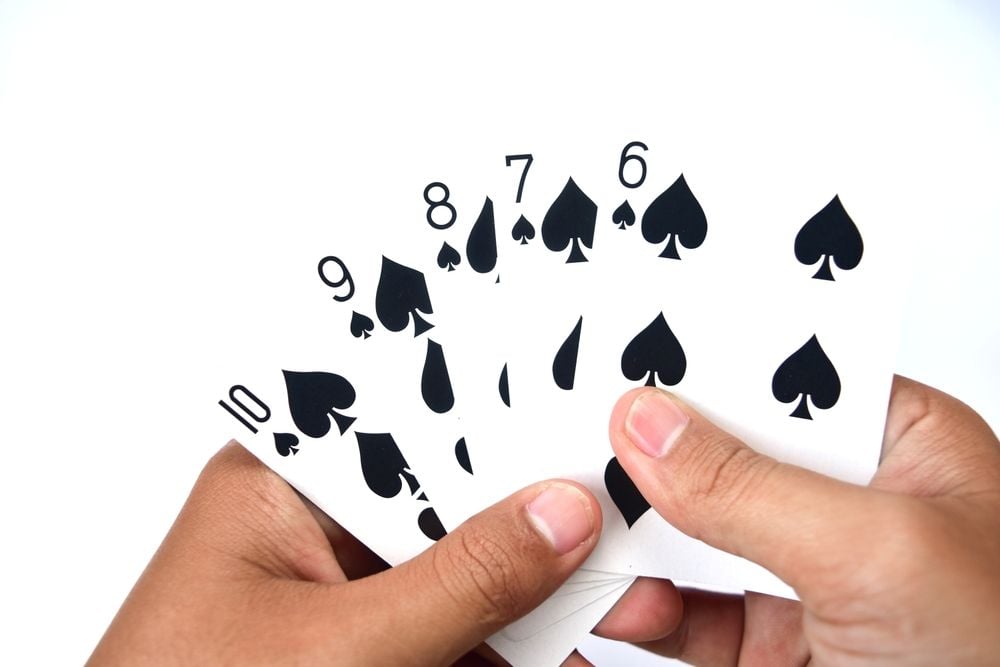
Image credit: Kitreel/Shutterstock
What is a Flush Draw in Poker?
Let’s start at the beginning. What is a flush draw in poker?
- What’s a flush in Texas Hold ‘em? A flush happens when you have five cards of the same suit. For example, you could have two spades in your hand and the board has three spades.
- What a flush draw in poker? A standard flush draw means you only need one more card to complete your flush. In this case, perhaps you have two spades in your hand and the board has two spades, meaning you only need one more spade.
Different Types of Poker Flush Draws
To truly master ‘what is a flush draw,’ you’re also going to want to understand the different variations.
- Nut flush: a poker ‘nut flush’ is the best possible flush any player can have. Usually this means the ace-high flush, but it can also indicate a ‘straight flush,’ where five cards are the same suit but also consecutive. (Ex. 2
 -3
-3 -4
-4 -5
-5 -6
-6 )
)
- A ‘nut flush draw’ refers to the possibility of hitting the nut flush. You will commonly hear players say, “I flopped the nut flush draw!” The nut flush is particularly important because it can beat other players’ lower flushes. A player holding A
 2
2 will beat a player holding K
will beat a player holding K Q
Q on 2
on 2 -7
-7 -J
-J -5
-5 -6
-6 because they have hit the nut flush. This is very unlucky for Player #2, because they have hit the second-nut-flush! (One rank lower than the nut flush).
because they have hit the nut flush. This is very unlucky for Player #2, because they have hit the second-nut-flush! (One rank lower than the nut flush).
- A ‘nut flush draw’ refers to the possibility of hitting the nut flush. You will commonly hear players say, “I flopped the nut flush draw!” The nut flush is particularly important because it can beat other players’ lower flushes. A player holding A
- Runner-runner/backdoor flush: Normally people only talk about flush draws when they only need to hit one card of a suit to make their hand. But you can also hit a flush with two cards… although this is much rarer. Perhaps you have 8
 9
9 and the flop is A
and the flop is A K
K Q
Q . In order to make a flush, both of the next cards would need to be a diamond. It’s a sneaky proposition known as going for ‘runner-runner’ or a ‘backdoor’ flush draw.
. In order to make a flush, both of the next cards would need to be a diamond. It’s a sneaky proposition known as going for ‘runner-runner’ or a ‘backdoor’ flush draw.
Identifying Flush Draw Opportunities – Learning the Mathematics
There are three times when you can spot a flush draw opportunity: before the flop, on the flop, and on the turn.
Before The Flop
If you are dealt two cards of the same suit, you are more likely to hit a flush, right? This is true… but it’s also a trap! Beginners tend to overestimate the value of their hand when they’re dealt two ‘suited’ cards (ex. Two diamonds, two clubs, etc.)
Do NOT play any two cards simply because they are suited
As a matter of fact, ‘suited’-ness only makes your hand 2-3% better.
Playing a hand just because it’s suited will get you in lots of trouble… and cause you to lose lots of money over time. A hand like K 7
7 may look good, but don’t be fooled — it’s a losing proposition.
may look good, but don’t be fooled — it’s a losing proposition.
The biggest rookie mistake a new poker player can make is playing too many hands. For more on which hands you should play, take a look at one of our cheat sheets.
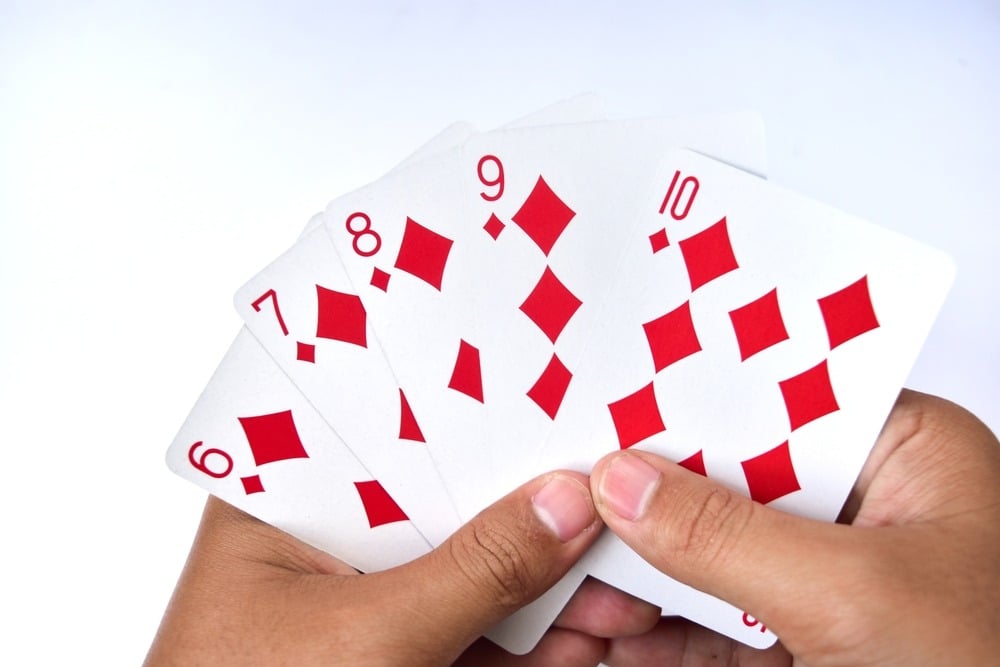
Image credit: Kitreel/Shutterstock
On The Flop
The greatest chance you will have at making a flush is on the flop. You may even ‘flop’ a flush — but again, this is rarer than you may think.
The likelihood of flopping a flush is 1 out of 118 times.
Ouch. That’s not good. But our memories deceive us — it’s easy to think of that one time you did flop a flush, and play any two suited cards again in hopes of repeating. Don’t do it. That vast majority of the time, your cards will miss.
What you find, however, is that you don’t flop a flush… but flop a flush draw.
This is usually worth sticking around and calling a reasonable bet. What does the math say? If you’re on the flop and only need one more card to complete your flush, the likelihood of it happening on the turn or river card is 36%. That’s intriguing — especially if you can win a big pot. But don’t go broke chasing flushes.
Unless there’s an exorbitant amount of money in the middle — boosting your ‘pot odds’ — you shouldn’t gamble your whole stack trying to hit something that will complete 36% of the time at best (assuming none of the cards that make your flush will make one of your opponents an even higher hand, like a full house).
On The Turn
Let’s say you’ve made it to the turn and you still only need one more card… but now things are getting dicey. It was 36% to hit your hand on the flop because we assumed you would get to see both the turn and river card.
Now you only have one card left to save your hand — and your odds drop in half.
The likelihood now of you hitting your flush has dropped to merely 18%.
Unless you’re getting a great price to see the river card — you only need to call a very small bet — you should often fold here. Sometimes we need to cut our losses.
What about a backdoor flush draw?
If you have a backdoor flush draw on the flop, your chance of hitting it is only 4%. This is why you usually want to ignore backdoor flush draws unless you have other draws with them to improve your mathematical equity.
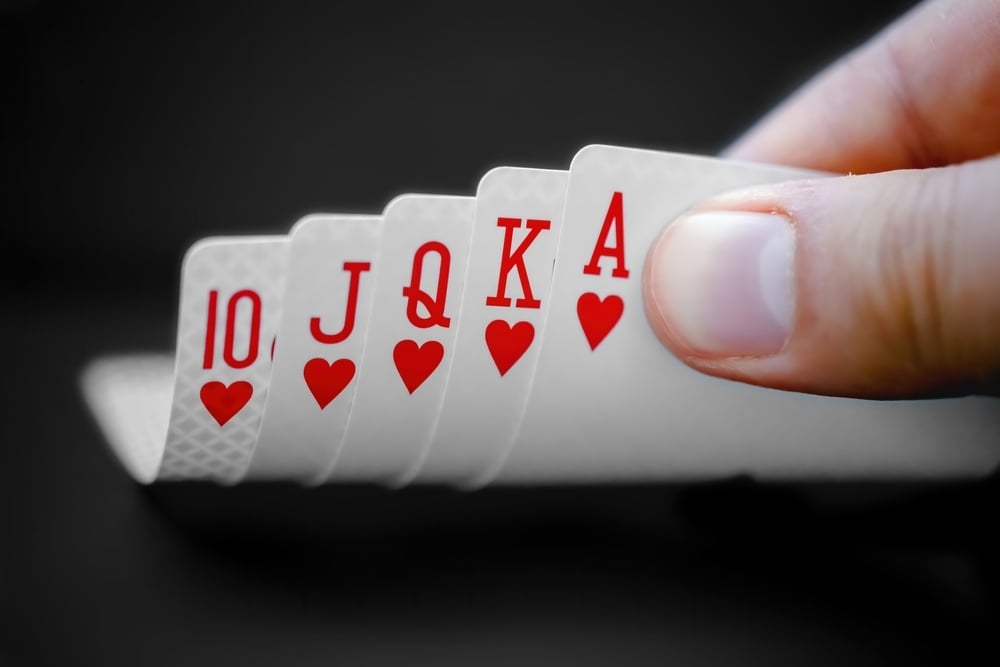
Image credit: Kitreel/Shutterstock
How do I Use Flush Draw Math to my Strategic Advantage?
Now that we know the math, there are key gameplay adjustments we can make.
- Be disciplined in hand selection. Do not play a hand just because the cards are the same suit.
- Recognize that trying to hit flush draws is gambling (36% at best). Only call bets when you have a flush draw when you’re getting a good price — the bet size to continue is cheap, or the pot size you can win is large enough to make the gamble worth it (‘pot odds’).
- Play ‘in-position’. When you are ‘in-position’ during a hand, meaning you get to act last, you can often check back and see the next card for free.
- Learn to bluff. Even if your flush draw misses, effective bluffing can scare your opponents into a fold, and you win the hand regardless.
- Price-out your opponents. If you believe one of your opponents is trying to outdraw you by hitting a flush, you can bet large to make it very expensive for them.
Final Thoughts: Maximizing Your Flush Draw Opportunities
Most beginners overvalue flush draws. It’s a major leak.
If you’re new to poker, your first priority should be learning exactly which cards to play, a ‘preflop chart’, followed by grasping mathematical outcomes.
What you will find is that suited hands probably played too big a part of your game. While chasing a flush can be tempting, the odds are usually not in your favor.
There are exceptions. Sometimes the bet size is incredibly cheap, or the pot size is so enormous it’s worth the risk. As you get more sophisticated in your poker game, you will also be able to use position to your advantage and play flush draws aggressively — allowing you to bluff your way out of situations when your cards don’t hit.
As a starting point, focus on understanding the different types of flush draws and their chances of hitting so you can make smarter decisions. Be selective with your hands, only chase draws when the odds are good, and use strategic betting to your advantage (and your opponents’ detriment).
Poker is about making the right choices. Knowing when to go for a flush or when to fold can greatly impact your success… and transform your win-rate.
]]>- The premise of the Iron Cross Craps strategy is that you have only one roll to win, making it a one-hit-and-down setup.
- The Iron Cross Strategy involves placing bets on the 5, 6, and 8, along with a field bet, to cover more potential outcomes.
- This strategy offers frequent wins, but while losses are less common, they can be more substantial.
- The Iron Cross betting strategy works just as well in online craps as it does in a local casino.
- Remember to set a betting limit to manage potential losses, as with all craps betting strategies. The Iron Cross is an exciting approach, but it doesn’t guarantee a win.
The Iron Cross craps strategy involves making use of the Place bets and the Field bet to give you a high chance of winning on every throw of the dice. Given the sheer number of bets and variety of possible strategies, the Iron Cross is one that’s easy to master.
In this article, we’ll review what the Iron Cross is all about and we’ll review the steps, the math, and answer the most important question: is the Iron Cross a good craps strategy to deploy in at the casino?
What is The Craps Iron Cross Strategy?
The craps Iron Cross strategy is popular because it is set up to cash in on a hot shooter. The Iron Cross craps strategy covers multiple numbers, so it produces regular, small wins. In a casino game like craps, where the house holds a small advantage, many players get more enjoyment if they can play longer and get frequent small wins instead of aiming for a unlikely jackpot win.
If that sounds like it’s a betting style that suits you, the craps Iron Cross betting method might be a good fit. You need only learn two basic bet types: Field bets and Place bets.
The goal is simple: use a combination of these two bets to cover every throw of the dice on the craps table except a 7. Specifically, we’ll use the Place bets for 5,6, and 8. Then we’ll use the Field bet for 2,3,4,9,10,11, and 12. As long as the dice don’t equal 7, you’ll make money on every throw.
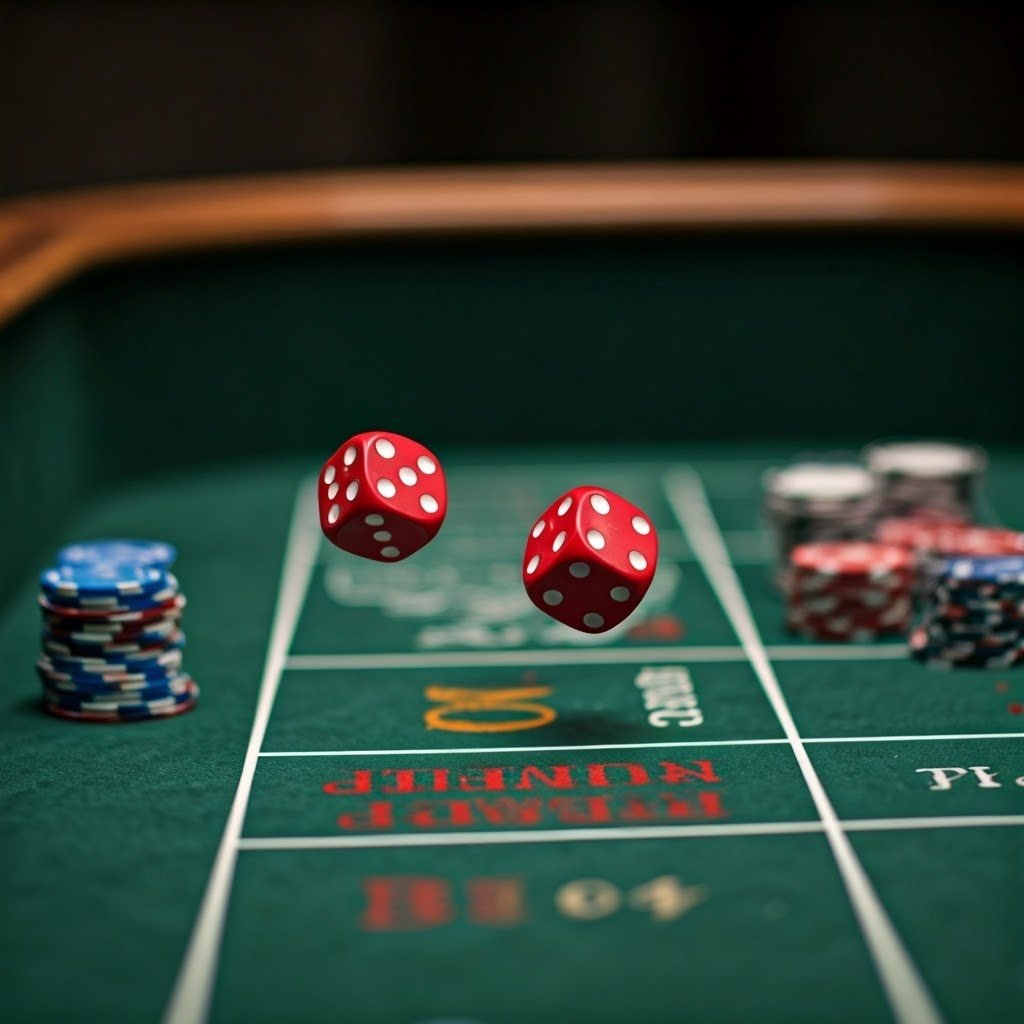
Image Credit: Shutterstock
Craps Iron Cross Strategy: Place and Field Bets Overview
Because Place and Field bets are a little bit off the beaten path in terms of craps bets, it’s good to do a quick review of the more popular bets in craps.
This baseline gives you a jumping-off point for understanding where and how the craps Iron Cross strategy differs from standard gameplay and betting approaches.
- Pass Line/Come Bet: While these bets are not part of the Iron Cross, learning them is to understand the essential flow of the game. Most people bet on a version of the Pass Line and/or Come bets. When you place these bets, the next roll results in one of three outcomes: a 7 or 11 wins (paying even money), a 2,3, or 12 loses. In either of those two outcomes, the Pass Line/Come bet is concluded.
However, should the first roll of a Pass Line/Come bet be any other number (4,5,6,8,9, or 10, collectively known as points) the bet changes and is now subject to a brand new set of rules. Your wager is now affected by two numbers: if the dice come 7, your Pass Line/Come bet loses, but if that point is rolled before a 7 appears, it wins and pays even money. The wager stays alive until one of those two outcomes.
We’re lumping these two bets in together because they behave the same way; the only difference is that players place Pass Line bets at the beginning of a shooter’s turn. Craps players place Come bets during the shooter’s turn.
Many players like to have wagers on several points at a time. By doing so, they stand to profit when a hot shooter comes along (someone who throws point after point without throwing a 7). Establishing points via Pass Line/Come is a valid option, but what if you don’t want to wait? Read on!
- Place: These bets mimic the Pass Line and Come bets that have passed and are tied to point throws. That is, they win if their point appears before a 7, they lose on a 7, and are unaffected by any other throw. However, there are a few important differences.
When you make a Place bet on a number, you’re selecting the specific point rather than taking what the dice give you, as you would on a Pass Line/Come bet. Also, that wager is active immediately on that number; there is no need to pass through the first stage of rules on Pass Line/Come (that win on 7 or 11 and lose on 2,3, or 12).
Payouts on Place bets vary with the number you select and are another difference with Pass Line/Come bets. For 6 and 8, you win $7 for every $6 wagered. For 5 and 9, you win $7 on every $5 wagered, and for 4 and 10, you win $9 for every $5 wagered.
- Field: this is a simple single-roll bet that pays off when the 8 least common numbers come up on the dice. Place this wager before any throw and you’ll win even money on 3,4,9,10, and 11. Most casinos will pay 2-to-1 on the Field bet if 2 or 12 appear. Field bets lose on 5,6,7, and 8.

Image credit: AzureAD/Wikimedia Commons CC BY-SA 3.0
Executing the Craps Iron Cross Strategy
The first part of the Iron Cross craps betting strategy involves making three simultaneous Place bets on the 5,6, and 8. Remember, Place bets stay in effect until their number hits or a 7 hits. Should any of these numbers come up your bet wins; you’ll collect your chips and re-make the bet if necessary.
Once a dealer recognizes you’re maintaining these active Place bets, they’ll only hand you your profits on a win, leaving the original wager in place as the roll continues.
Adding in the Field Bet
Once you’ve made Place bets, you’re ready for the second part of the Iron Cross craps strategy: the Field bet. This is one of the few wagers the player can make without the assistance of the craps dealers. Field bets win or lose on every throw of the dice, so be ready to replace losses.
The amount you wager depends on the minimum bet at the table. Start with the minimum bet size for the Field bet and the Place 5 bet. But you’ll want to make Place bets on the 6 and 8 in $6 increments, so these wagers will always be a little bit bigger.
For example, at a $15 minimum table, you’d place $15 bets on the Field and Place 5, then for the Place 6 and 8, you’d make $18 wagers, which is the closest multiple of 6 that meets the minimum bet requirements.
Example Craps Iron Cross Strategy Game Flow
You’re at a $10 minimum bet craps table. Here’s how an Iron Cross might play out. Note that when you win, some dealers leave your original bet alone and just slide your profits to you. If they return your original bet as well, you’ll need to remember to replace that wager before the next roll.
Before the dice are out, that is, before the stickman has pushed the dice to the shooter (which is an indication he or she is free to roll) you place a $10 wager directly onto the Field bet.
Then you take $34 in chips, push them in front of you in the Come bet area and tell the closest dealer on to place the 5,6, and 8. The dealer puts $10 on Place 5, and $12 each on Place 6 and 8.
- Roll is a 5. Your $10 Field wager loses; you’ll need to replace it with another $10 in chips. Your Place 6 and 8 bets are unaffected but your Place 5 bet is a winner. The dealer will slide $14 in profits to you. So far you’re ahead $4 ($14 minus the $10 on the lost Field bet.)
- Roll is a 2. All Place bets are safe, and your Field bet is a double winner! (Remember 2 and 12 get paid out 2-to-1). The dealer slides $20 in chips to you.
- Roll is an 8. The Place 5 and Place 6 are unaffected, and the Place 8 is a winner, netting you $12. Your $10 Field bet loses so you replace it. This throw earned you $2.
- Roll is a 10. Place bets are unaffected. Your Field bet is a winner, netting you $10 for this throw.
- Roll is a 4. Place bets are unaffected and the Field nets you another $10.
- Roll is a 7. All four of your bets lose and are raked. For this sequence, you made $46 against $34 in wagers, resulting in a $12 profit.
Players using $10 Pass Line/Come bets to establish points would have gotten hit hard in this sequence. An initial Pass Line bet would have gone to 5, followed by a losing Come bet when the 2 appeared.
Players who kept betting the Come would have gotten $10 bets established on the 8,10, and 4 before seeing all bets wiped out by the 7 before any of the points had paid off.
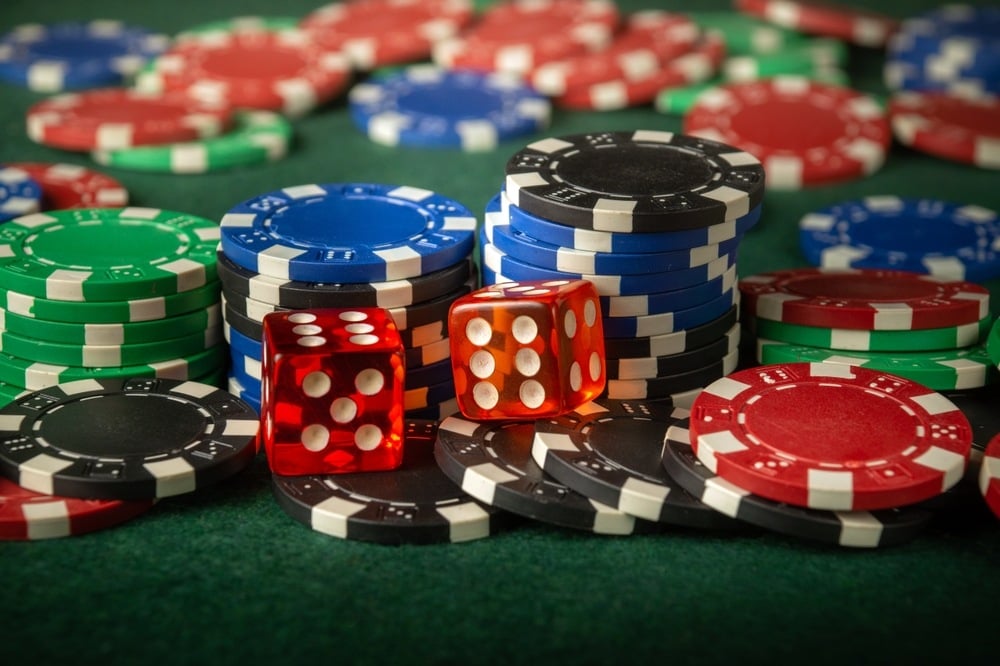
Image Credit: VITALII BORKOVSKYI/Shutterstock
Advantages of the Craps Iron Cross Strategy
If you followed the example above, you can see that best outcome is when Field numbers appear because the result is pure profit. And when the Place bets win, it’s at least enough to cover the lost Field bet. Here are some positives about the Iron Cross craps strategy:
- Wide Coverage: With a Field bet plus Place bets on 5, 6, and 8, every outcome is covered except for 7.
- Frequent Wins: There are 36 possible combinations using two dice; six of those result in a 7. That means when you play the Iron Cross, 30 of 36 rolls (83.3%) have a positive outcome.
- Fun: Frequent wins makes for engaging and exciting gameplay.
Variations of the Iron Cross Craps Strategy
There are several variations of the Iron Cross strategy that players can explore:
- Pressed Place Bets: Instead of taking your profit on a Place bet win, you can tell the dealer to “press it.” That’s craps language that indicates to the dealer that you want to use your winnings to increase the size of your bet.
- Differential Place Bets: Because the Place 6 and 8 have a smaller house edge, some players like to bet a little more on these two bets. At a $10 table you might have $18 each on Place 6 and 8.
- Other Bets: Advanced players might enhance their wins on Place 6 and 8 by also betting Hard 6 and/or Hard 8 bet, which pay a bonus when the number comes up as a double (e.g. if 6 is rolled as 3-3). ?Just remember Hardway bets have a big house advantage, so they’ll add some flavor to your game, but they won’t help your odds of winning.
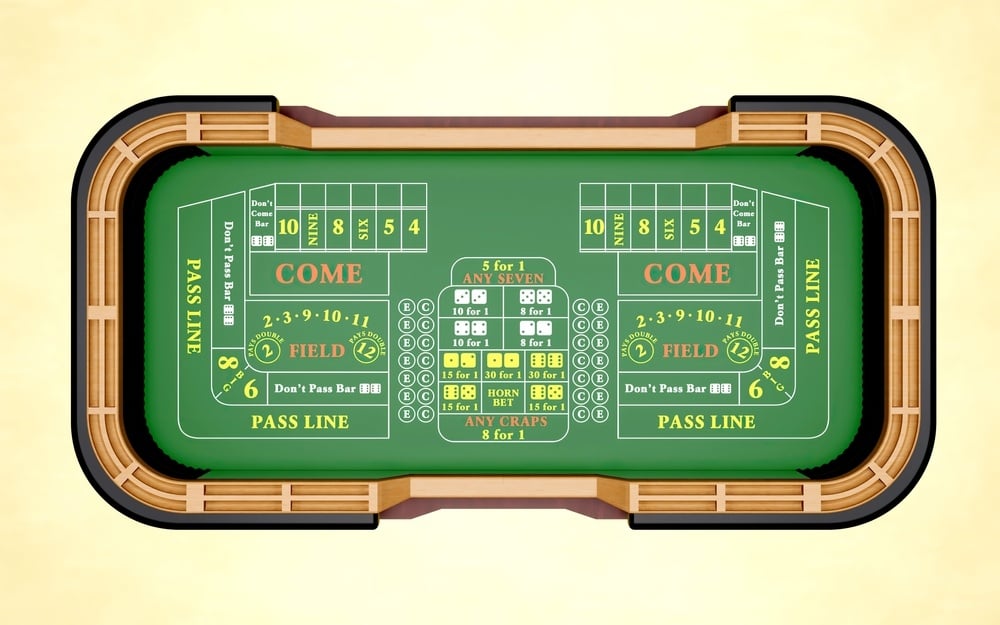
Image Credit: Shutterstock
Disadvantages Of The Craps Iron Cross Strategy
While the Iron Cross strategy has several advantages, it’s no craps panacea.
- Overall House Edge: no betting strategy or sequence can overcome a game where the individual bets have a house edge. The Iron Cross is a gameplay strategy to maximize the craps experience, but it is not a strategy that will make money in the long run.
- Field Bet: To put a finer point on the house edge question, any strategy that relied on the Field bet should be met with skepticism. The house edge on a standard Field bet is 5.56%. However, some casinos offer 3-to-1 on either 2 or 12 (but rarely both) instead of the standard 2-to-1, cutting the edge down to 2.8%.
- Limited Big Wins: The Iron Cross betting approach is more likely to deliver small, frequent wins versus other multi-number strategies which can deliver bigger profits on a long roll.
In a qualitative comparison, the Iron Cross strategy stands out for its frequent wins and engaging gameplay. However, quantitatively, strategies involving pass line and come bets with full odds offer a lower house edge and higher potential payouts, making them more favorable for long-term play.
Win More Stacks With The Craps Iron Cross Strategy
The Iron Cross strategy offers an engaging way to play craps, appealing to players who like seeing a steady stream of chips come their way, however small the stacks are.
While it provides a sense of momentum and excitement, it also comes with disadvantages such as the house edge and limited potential for big wins. But as long as you know the pros and cons before you play, you might just find the Iron Cross to be the perfect intersection of risk and reward!
Title Image Credit: VITALII BORKOVSKYI/Shutterstock
]]>- A 3 bet is the 3rd bet in a poker round, when a player raises on the 2 bet in poker, or the initial preflop raise.
- This happens when one player bets, another player raises, and then either the original bettor or another player makes another raise. This second raise constitutes a 3 bet
- In Texas Hold ‘Em and Omaha Poker, the blinds are considered the first bet, which is why the second raise is a ‘3 bet’
- For example, if one player raises to $15 before the flop, and the other player makes it $45, the player raising to $45 is making a 3-bet.
- Preflop betting is a huge part of poker strategy. This guide will take you through exactly what poker 3 bet is, how the value of your poker hands factors into your decision making, and how to build and implement a three bet in poker strategy.
A 3 bet in online poker is a a raise made after another player has made a raise already. Although the expression is often used to describe pre-flop action, a poker 3 bet can also happen after the flop.
During a poker game, 3 betting is an important part of poker strategy, from video poker to live dealer poker, allowing players to increase their aggression levels, resulting in winning more pots when bluffing and scooping bigger pots with the best value poker hands.
Figuring out when to 3 bet in poker, how to size your 3 bet poker properly depending on a situation, and what poker hands to pick can be tricky, but it is essential on your path to becoming a successful and profitable poker player in the long run.
What is a 3 Bet in Poker: The Basics
If you’re new to the game of online poker, the definition in the introduction will give you an idea of a 3 bet is and how it works. However, the definition alone doesn’t explain what makes this bet different from other bets and why it’s so important to develop a deep understanding of this concept.
There are several main goals that we want to achieve when placing a 3 bet in poker, and we can accomplish two or more of these with a single bet:
- Taking control of the betting – When you 3 bet in poker before the flop, players who stick around will usually call, giving you control of the betting on future streets.
- Hand protection – When you have a strong hand, 3 bet poker helps you reduce the number of players to the flop, making it easier to realize your equity.
- Isolating weak players – You can use 3 bet poker to target weak players and attack their raises, ensuring you play them heads-up by removing other players from the pot.
- Making you harder to play against – If other players know that you are capable of 3 betting, they’ll be less likely to attack your blinds, and when they do, they’ll have to fight harder for the pots.
Like with every other aspect of poker strategy, such as ICM in poker, finding a good balance is crucial. You want to 3 bet at the right frequency and with the correct poker hands to make the most out of this move.
Most players don’t do it enough, but there are also those who make one of the top 10 mistakes in poker, 3 betting too often, leaving them exposed to observant opponents who’ll take advantage of this tendency.

Image credit: Andrew Angelov/Shutterstock
What Does 3 Bet Mean in Poker: Purpose & Strategy of a 3 Bet in Poker
A 3 bet in poker is one of the most powerful moves when it comes to pre-flop betting. In many lower-stakes games, players don’t know how to properly respond to it, and very few have balanced 4 betting ranges. This means that a good 3 betting strategy can give you a big edge.
By attacking a pre-flop raise, you’re conveying a message that you have a strong hand, allowing you to pick up the pot right then and there or proceed to the flop with an advantage.
On high-card boards, you’ll have a range advantage, and on lower and middling boards, you’ll still have some coverage because of a balanced poker strategy that doesn’t include just the best poker hands.
When deciding whether to play 3 bet poker or not, there are a few things to look at:
- The raiser table position – A player raising from a late position will usually have a weaker range, which means you can attack it with a wider scope of poker hands. Conversely, an early position raise conveys more strength, which should lead to a tighter 3 betting range.
- Your hand – Your hand is important when deciding whether to 3 bet. Some of your strongest holdings will want to 3 bet almost always, while other poker hands are good candidates for light 3 bets, especially against late position openers.
- Stack sizes – It’s important to be aware of all relevant stack sizes and poker chip values when making a pre-flop 3 bet. If there are particularly short stacks still to act or the original raiser doesn’t have many chips behind, you should usually tighten your 3 betting range.
In addition to these general considerations, you should always think about any specific reads you have on the player whose raise you’re attacking.
If you know someone to be opening a very tight range in general, you’ll want to deviate from your standard pre-flop poker strategy and skip on some of the weakest theoretically correct 3 bets. By the same token, against players who open too frequently and have a wide opening range, you should be looking for opportunities to 3 bet in poker.
That said, always try to think beyond the pre-flop. If you know someone is sticky and will often call a 3 bet to see the flop, you should increase your frequency when in position and avoid some of the marginal 3 bets when out of position.
What is 3 Bet Poker: Types of 3 Bets
We’ve already talked about some of the main goals we want to achieve when 3 betting. With these goals in mind, 3 bets can be divided into three main groups:
- Value 3 bets – These are 3 bets done with the strongest part of our range, like big pocket pairs, AK, and AQ. What exactly our value poker 3 bet range looks like will depend on the position where the raise is coming from, and any reads we have on the player. For example, pocket 9s are a value poker 3 bet against a button open, but we can’t raise with them for value against a reasonable UTG (under the gun) raise.
- Bluff 3 bets – Certain poker hands play very well as bluffs before the flop. Some of the best bluffing 3 bet candidates are small suited aces because of their ability to flop flush and straight draws, which allow you to put a lot of pressure on your opponent.
- Semi-bluff 3 bets – When talking about semi-bluff 3 betting poker hands, we’re talking about post-flop situations. With certain drawing hands, you’ll want to go for a 3 bet poker to put the maximum pressure and try to win with aggression while still maintaining some equity if you get called.
What is a 3 Bet in Poker: Important Factors to Consider
Armed with the answer to ‘what is a 3 bet in poker?’ what its main goals are, and the three major types of 3 bet, we can now move on to the most important part: the implementation.
It is one thing to say that it’s good to 3 bet because it helps us improve our aggression and win more pots. It is an entirely different thing, though, to figure out when to 3-bet in poker and what are some of the most important factors to pay attention to besides the one we’ve mentioned earlier.
Poker Game Dynamics
Game dynamics will play a huge role in how you construct your 3 betting ranges. While you can use GTO charts as your starting point, you shouldn’t be following these blindly, especially in lower stakes and live games, where players often have pronounced tendencies that you can take advantage of.
When figuring out your pre-flop strategy for a particular poker table at a casino, you should first figure out how that table plays overall. Are general tendencies more passive or are they on a more aggressive side? Are players opening a lot of hands, are there many callers before the flop, etc.?
This also applies to games of online poker, live dealer poker, or video poker. The same poker strategies apply to digital games as much as local casino games.
This information will help you create an idea of what their tendencies are and what their hand ranges look like. Based on this knowledge, you can make adjustments to your 3 betting strategy, adding or removing hands and deciding if including some of the marginal poker hands makes sense or if you should stick to a tighter, more straightforward approach.
Player Stack Sizes
Likewise, you should also be aware of stack sizes, especially in tournaments, where this is one factor that changes constantly.
Perhaps the player to your left has been on a 50+ big blind stack for the entire poker tournament, but they had just lost a huge hand, and now they are down to just seven or eight big blinds. This is something you have to consider when deciding whether to 3 bet light, as you’ll be committed to calling that player’s all-in once you 3 bet.
In cash games, you won’t often have to deal with short stacks, but you should be careful when entering pots against extremely deep-stacked opponents. When 3 betting in these situations, you need to have a solid plan for future streets and a general idea of how you want to proceed in a pot when you miss or make a marginal hand.
It doesn’t take that much for a pot to balloon out of control, and it usually starts with a 3-bet before the flop, so you must always be very aware of all stack sizes and seriously consider them when making your decisions.
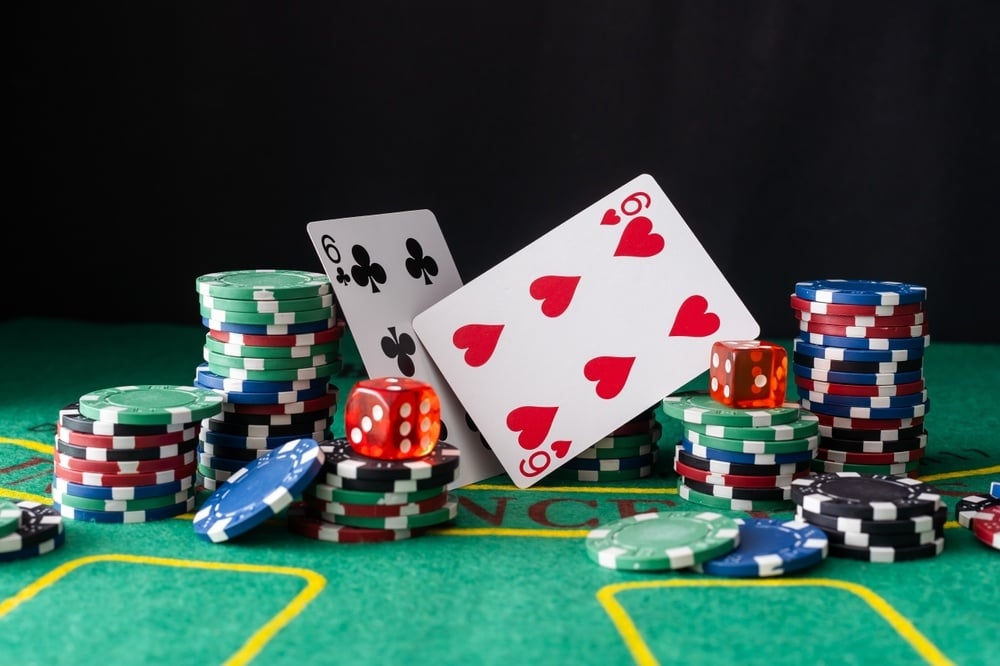
Image credit: Vasilchenko Nikita/ Shutterstock
Common Mistakes to Avoid When 3 Betting
Playing aggressive poker at a online casino isn’t just effective. It’s also fun and exciting, so it’s not hard to fall into the trap of taking things too far. To help you avoid these situations, here are a few common mistakes and pitfalls to avoid when it comes to 3 betting:
- 3 betting too much against early position opens – Unless you have a very specific reason to think otherwise, you should respect early position opens and only go after them with very strong poker hands. This is especially true when you are in an early position as well and have several players to act after you. Many players tend to forget about other people involved in a hand and focus only on the original opener, which can be a costly mistake to make.
- Not balancing properly – When 3 betting, you have to make it difficult for your opponents to put you on a hand. If you’re 3 betting only with your strongest poker hands, good players will quickly pick up on it. Instead, you want to use what’s known as a “polarized” range, which includes your best hands but also a decent number of weaker hands.
- Using a bad sizing – It’s very important to use a proper size when 3 betting. While there is no one magic number, you want to make the 3 bet big enough so that it’s not an automatic call for your opponent with their entire range. This is especially true when 3 betting out of position, as you almost never mind picking up the pot on the spot. When playing deep-stacked, good players will often use big 3 bet poker sizes to make it harder for their opponents to call and to send a clear message that if they do call, they might end up playing for the stacks by the river.
For example:
If you’re playing 200 big blinds deep and face a cutoff raise in the big blind, you will often want to 3 bet with a hand like Ah5h. But if the cutoff opens to 3 BBs (big blinds), you should 3 bet to at least 10, and maybe even 12 big blinds.
Anything smaller will make it an easy call for a player in position, and that eliminates a big part of the reason you’re 3 betting in the first place, i.e., to win the pot without going to the flop.
Advanced 3 Betting Tactics
The concept of 3 betting in poker is a vast and very important topic, so this article, as long as it is, doesn’t nearly cover all of the different angles and nuances there are to this move.
With that in mind, we’ll quickly go over some advanced 3 betting tactics that can help nudge you in the right direction as you look to improve and solidify your pre-flop strategy.
Creating a Balanced 3 Bet Poker Range
We’ve mentioned a few times in this article the importance of a balanced 3 betting range, but what does this mean exactly? There isn’t a one-fit-all answer to this question, as what your 3 betting range looks like will depend on stack sizes, positions, and player tendencies.
Generally speaking, though, you want to have a range that has your good poker hands balanced out with enough weaker hands so that your poker strategy isn’t too predictable.
For example:
If you’re 3-betting hands like AK, AQ, KQs, and pocket pairs down to pocket 10s for value, you will want to include hands like KQo, A2s – A5s, and some suited connectors into your 3 betting range to create a good balance.
Paying Attention to Poker Hand Frequencies
In addition to figuring out a solid range, you also need to think about frequencies. If a hand like KQo is in your 3-bet bluffing range, this doesn’t mean you’ll want to 3-bet with it every time. Maybe you’ll do it 70% of the time and fold it the remaining 30%. To balance this out, you’ll sometimes just call with your strongest poker hands like pocket Aces.
Combining 3 Betting With Other Post-Flop Strategies
In the ideal world, your opponents would be folding to all of your 3 bets, and you’d be printing money. In the real world, however, this doesn’t happen, and you’ll often have to play in 3 bet poker pots across multiple streets.
When devising your 3-bet poker strategy, you always need to have this in mind. The moment you make a 3 bet, you should be thinking about different scenarios and how you want to tackle them. What sort of boards will you be continuing on, what board textures are best to check on, and what, if any, opportunities there are to go for a check-raise?
When planning all this, you’ll have to think about more than just your hand. Your opponents’ ranges, tendencies, and stack sizes will play a huge role in how you devise your post-flop strategies in 3 bet poker pots, but those fall outside of scope of this particular article.
What is a 3 Bet In Poker: Your Questions Answered
- Is a 3bet better than an open raise? – The benefits of a 3 bet in poker over an open-raise is that a 3 bet will often force players with weaker hold cards out before the flop, reducing competition for the pot. With a good 3-bet, you might also pick up the entire pot preflop, which you cannot do with an open-raise.
- What is a linear 3 bet poker range? – A linear 3 bet range is a list of poker hands, in descending order a value, that are strong enough to 3 bet on. A linear 3 bet range is one composed exclusively of value-bets.
- What hands should I 3bet with? – As noted, there isn’t one straight answer to this question. It will depend on table dynamics, stack sizes, and whether you’re using polarized or linear betting ranges. Familiarizing yourself with all aspects of pre-flop betting is the best way to decide on which poker hand to three bet on at any given time.
Adding 3 Bet Poker to Your Poker Strategy
A poker 3 bet is one of the most powerful weapons in a player’s pre-flop betting arsenal. Knowing when to 3 bet, what hands to do it with, and how to properly size your 3 bets to get value and deny your opponents’ equity is essential to your long-term success in poker.
While we covered many important aspects of the 3 betting poker strategy in this article, the bulk of your knowledge and understanding will come from practice and analysis. Don’t be afraid to test different things against different players and then spend some time analyzing these spots.
A little free video poker is a great way to practice your 3-betting without spending a dime!
With time and practice, you’ll be able to pick up many interesting trends and flaws in both your and your opponent’s game, allowing you to improve and perfect your 3 betting poker strategy.
When used correctly, this can be one of the most powerful tools in your toolbox. Most players, especially those new to the game, are afraid of a poker 3 bet, whether when they have to face them or when they’re the ones who should use them. Break away from this pattern, develop an understanding of this important porker strategy concept, and you’ll quickly see significant improvements in your results!
Title image credit: Bordovski Yauheni/Shutterstock
]]>- A “gutshot” in online poker is a hand in which a player is one card short of a straight, but the missing card is in the middle, not at either end.
- This is also known as an inside straight draw or belly buster, where the player needs to draw one of four cards to complete the straight.
- Gutshots are considered weaker poker hands because they have fewer outs (cards that will complete the draw) compared to open-ended straight draws.
- Betting or calling on a gutshot is often considered risky, but it can pay off if the situation is right, especially if this unexpected move can be used to mislead opponents.
- Understanding when to pursue a gutshot — considering factors like pot odds, implied odds, and your opponents’ tendencies — can elevate your poker strategy.
If you’re playing online poker, live dealer poker or video poker, or sat at your local casino, a poker gutshot draw is the weakest one out there, as you only have four outs that can help you. Yet, many beginners, who are just starting to learn poker, tend to overestimate a single gutshot and will often put way too many chips into the middle with this type of hand.
For this reason, it’s important to talk about poker gutshot draws and explain math and other strategic considerations behind them. Generally speaking, this is not a strong hand, but if you know how to play it correctly in different situations, it can be a profitable one.
What is a Gutshot Draw in Poker?
A gutshot straight draw is a straight draw that can only be completed with a specific card (four outs). For example, on a board of 3S 4D QD, a player holding 6H 7H has a gutshot, as only a five will complete the draw and turn it into a made straight.
Another example of a gutshot draw would be holding KA QS on a 9H 3H 5C board. In this example, you need one of the four Jacks from the deck to complete your draw, and this is what it is referred to as a single gutshot.
There are also double gutshot draws, but we won’t be covering them in this article, as their math is essentially the same as for open-ended straight draws. For example, if you have 6C 9C on a 5H 7H 3C, you can complete the draw with eight cards – four 8s and four 4s, which is the same number of outs you have in an open-ended straight draw.
It is important to be aware of gutshot draws on the board and cards that can potentially complete them on turns and rivers. Poker beginners often miss these and end up paying their opponents when they hit because they fail to recognize a straight-completing card.
As already mentioned, a gutshot in poker is one of the weakest draws you can have. Your odds of making your draw from flop to turn are just 8.5%, and the odds of hitting one of the four cards you need by the river are 16.5%.
These low percentages indicate that you should never play a big bet with just a gutshot draw if you believe the only way of winning the pot is by making your hand. In these scenarios, when facing any bet that is 50% of the pot or larger, you should just fold and move on.
Interpreting Gutshots in Poker Play
For beginner players, a gutshot can be a rather confusing hand. Without understanding the math we’ve just explained, it’s hard to understand why these hands aren’t worth chasing after. After all, if you make your straight, you can get paid, right?
The problem is, compared to all other draws, a gutshot straight is the least likely one to come in. For example, an open-ended straight draw will fill in almost 32% of the time by the river. The odds of completing a flush draw are even higher at 35%.
Some of these hands, flush draws especially, also have other “backup” features, such as hitting a top pair that might also give you a winner. Gutshots usually lack these properties and hitting a top pair when you have a gutshot can often be a bad thing, as that same card could complete the opponent’s straight draw.
To illustrate, if you have 7C 8C on a 4C 6H JH board, when you improve to a top pair with an 8 on the turn, that same card completes the potential open-ended straight draw from the flop (any 5-7 combo), and depending on the action, this combination can easily be in your opponent’s range.
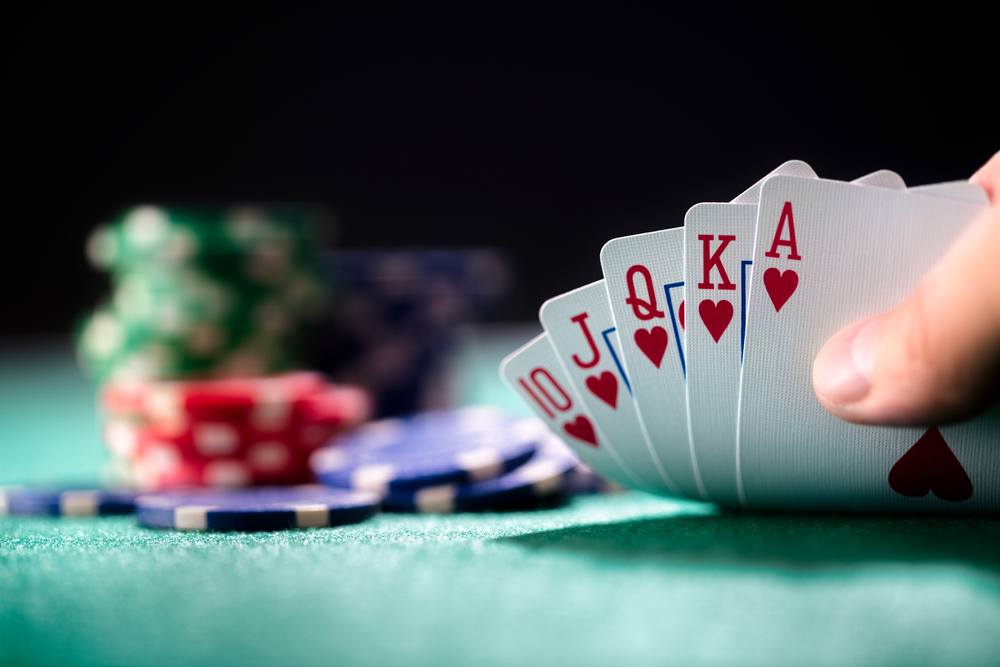
Image credit: VITALII BORKOVSKYI/Shutterstock
Playing Gutshot Draws Effectively
The first part of this article mainly focused on explaining what a gutshot is in poker and why you need to approach these hands very carefully and conservatively. However, with the right gutshot poker strategy, you can make these draws work for you.
There are a few things that you need to consider when you flop a gutshot draw:
- Am I in or out of position?
- Can I only win a hand by making a straight?
- If I make my hand, will I be able to win additional chips?
First of all, when you are out of position in poker, and you have a gutshot draw, I’d say that if you believe your only options are call or fold (when facing a reasonably sized bet), you’re always better off folding. Calling to try and hit an unlikely draw out of position isn’t a profitable strategy.
Sometimes, however, a gutshot straight draw can be a perfect hand to use as a check-raise bluff. On small and relatively connected boards, you’ll often have a range advantage as a player defending from the big blind. In these spots, using gutshots as semi-bluffs can be a valid strategy.
The main idea behind the move is to get your opponent to fold as you can credibly represent a strong hand. However, if they don’t, you still have some equity to fall back on.
For example, you face a hijack open and call from the big blind with 7S 8S. The flop comes 4H 5C 9D. When you check and they continue betting, you can credibly raise, as this is the board where you’ll have more sets, two-pair, and top-pair combinations. When you do get called, you can still hit a 6 to complete your draw.
Of course, it is important to find the right balance. You aren’t supposed to check-raise with 100% of your gutshots, and when you are in position, you can often just call and see what develops on the turn or river. When and if they give up, you can take a stab at the pot, depending on the texture, player tendencies, stack sizes, etc.

Image credit: VITALII BORKOVSKYI/Shutterstock
Common Mistakes With Gutshot in Poker
We’ve already covered some of the most common mistakes with gutshot poker draws, but it’s good to try and list them all in one place for reference:
- Calling big bets, especially out of position
- Investing too much money with non-nut draws
- Continuing in the pot when you miss your draw and hit a pair instead
- Taking an aggressive approach when the opponent is on a very short stack
- Not getting enough value from made draws
You need to assess every situation individually and decide what the best course of action is. It’s easy to go on autopilot and fall into the trap of playing automatically, but check-raising against an opponent who only has six or seven blinds left is usually not going to work.
Likewise, if you’re going to chase a gutshot, whether by calling or by playing aggressively, you need to have a plan to extract the maximum value when your draws come in. Because these hands do not materialize often, you must make the most out of them whenever they do.
Advanced Techniques for Handling Gutshot Draws
Successful poker players don’t look at any individual strategy in a vacuum. Instead, they study and implement it as a part of a broader game plan, and this is exactly what you should be doing with your gutshot poker strategy.
The approach of let’s call or raise and see what happens is not the correct one. Instead, you need to take a few moments to make your decision, and during that process, you’ll want to figure out how to play out the rest of the hand.
If you go for a check-raise with your gutshot, you’ll want to have a plan on what happens when different cards hit. Likewise, if you call a bet, you should have an idea of how to play out future streets.
For example, if you call with a gutshot on a 4S 5S JD board, what do you do if turn pairs a 4 or a 5? These are cards you can credibly represent, so these can be good opportunities to take over the betting lead or put in a turn check-raise.
This way, you’re not relying on just the luck of a draw to win the pot but are instead giving yourself other opportunities to take it down.
Of course, factoring in general population tendencies and any specific reads you have on a player will be very useful. You should be less inclined to take an aggressive approach against an opponent that you know is sticky and will not fold easily.
At the same time, this is the type of opponent that you want to try and make your draw against even if you aren’t getting immediate odds, as you know they’ll be willing to put more money into the middle when you hit.
These are just a few simple examples of how you can adjust your gutshot poker strategy. There are many different scenarios and many different types of players you’ll encounter, but as long as you keep in mind the basic principles of this hand, you should do just fine.
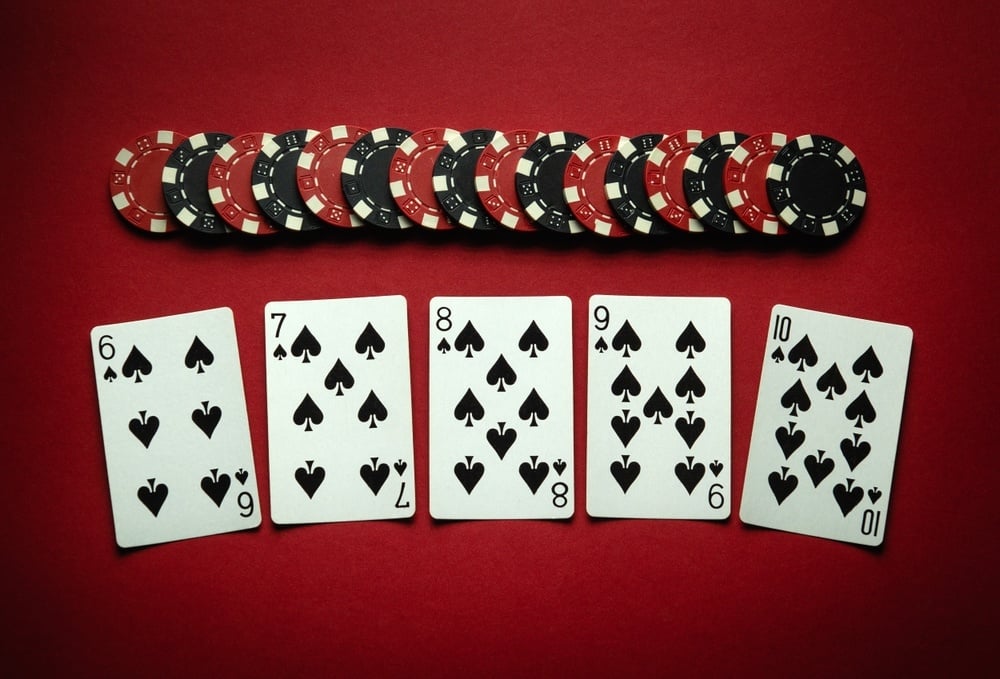
Image credit: VITALII BORKOVSKYI/Shutterstock
Gutshot in Poker Examples & Hand Analysis
It’s always easier to understand certain theoretical concepts when looking at real-life examples, so here’s an interesting hand played by Jonathan Little featuring a gutshot straight draw.
- Jonathan starts off with AC 2C in the hijack and makes a standard 2.5x raise (blinds are 200/400). The button. The big blind call and the flop come 7D 4H 3C, giving him a gutshot and a backdoor flush draw.
- After the big blind checks, he decides to continue for 1,700, and only the button calls. The turn is the 9C, bringing in the flush draw as well. This is where the backdoor potential kicks in – the hand isn’t just a gutshot, but it also has many cards that will allow it to keep betting.
- Now Jonathan bets 2,600, and the opponent calls once again. The river is the QC, completing the flush. Little goes for a massive bet of almost 19,000 into the pot of 12,500 to really put the opponent to the test.
This is a great example of playing a gutshot aggressively all the way through, realizing the full potential of the hand, and taking advantage of favorable turn and river cards.
If, however, Jonathan had a hand like AS 2S or AS 3S in this spot, without any backdoor opportunities, he’d probably take a much more cautious route, likely checking the flop against two opponents and giving up to any reasonable aggression.
Tips for Improving Gutshot Play
There are a few different ways to improve your gutshot poker strategy, but running simulations with these scenarios and looking at the numbers that come up is probably the best one.
When you do it enough, you’ll develop an understanding of how to tackle different board textures and play from different positions, realizing how often you should be bluffing with what types of hands and what hands are best played passively.
It goes without saying that seeking tips and advice from more experienced poker-playing friends can also help immensely. Since these can be very tricky spots, don’t be afraid to pick their brains and ask them what they think, as they can open your mind to some new possibilities that you’d never think of on your own.
The Gutshot Draw Unveiled: Elevating Your Poker Game with Strategic Insights
Gutshot straight draws are one of the most frequently misplayed hands in all of poker. Beginners make the mistake of overvaluing these hands, leading them to lose a lot of chips in spots where they had absolutely no need to do so.
Hopefully, this article will help deepen your understanding of the gutshot poker strategy and teach you how to get the most out of these draws. When navigated correctly, these hands can be profitable, especially against weaker competition that won’t be able to wrap their head around your play.
Keep on playing and studying, analyze different spots, and take advantage of different poker tools to help you develop the right strategies for gutshot straight draws, and it won’t take you long to start playing better than a large percentage of players in these spots.
Title Image credit: VITALII BORKOVSKYI/Shutterstock
]]>- Heads Up poker is a thrilling form casino game played between just two players, requiring a unique strategy and understanding of your opponent’s tendencies.
- Position is paramount in Heads Up poker. The player on the button acts first pre-flop but last post-flop, creating strategic implications.
- The range of poker hands you play should be wider in Heads Up poker. Even hands considered weak in full-ring games can be strong heads up.
- Observing and adapting to your opponent’s patterns in video poker or at the casino and playing style is essential to success in a one-on-one match.
- In Heads Up poker, aggression often pays off. Players need to be prepared to bet and raise frequently to exert pressure on their opponents.
Are you looking to play – and master – heads up poker? You’re in the right place. Brace yourself for one of the purest, most iconic, and volatile forms of No Limit Texas Hold ‘Em.
How to Play Heads Up Poker: The Basics
To get started with the poker table positions:
- Place a ‘button’ marker in front of one player. This can be any object — an empty deck of cards box, a cup, an eraser, a lucky rabbit’s foot. As long as it’s easily visible to both players, you can use it as your button.
- The button player will act as the ‘small blind’. Player two will act as the ‘big blind.’
- If the game is $1/$2 for example, the player on the button would pay $1 and their opponent would pay $2 before any of the cards are dealt.
- The button player acts first preflop, and the big blind acts last post flop.
- Rotate the button each hand.
What is The Difference Between Heads Up Poker And Ring Games
The main differences between heads up and ring games are as follows. Typical ‘ring games’ will have a full table of players. (Online poker tables are usually six-handed and live casinos generally seat 8 or 9 players per table.)
Because you are not waiting for an entire table of people to make their decisions, heads up poker is much faster. You will see many more hands when you play heads up than when you are in a full ring game. Strategically, ring games require patience. Heads up requires aggression.
Breaking Down the Poker Jargon
‘The button player acts first preflop, and big blind acts last postflop’ — huh? What does this mean?
I’ll simplify the poker jargon for you. Here’s an example.
- You and your friend are playing $0.25/$0.50 heads up poker.
- You are on the button which is always simultaneously the small blind and pay $0.25.
- Your friend in the big blind pays $0.50.
- You are each dealt your two private hole cards face-down. In this scenario, you are dealt a fantastic pair of aces!
- You raise to $1.50.
- Your friend calls the $1.50. Since they already have $0.50 invested, they only need to contribute $1.00 more.
- The flop — three public, face-up community cards — is dealt. In this case, the flop reveals: 2
 6
6 A
A
- Wow! You’ve hit three-of-a-kind! But it’s your friend’s turn first. You must wait for them to make a decision. Your friend opts to check (no bet).
- Now it’s your turn. You bet $2.00.
- Your friend folds.
Do you see how you made the first decision before the cards were dealt? But after the cards were dealt, it was your friend’s turn first? This is the sequence of heads up poker… and then you rotate positions after the completion of the hand.

Image Credit: Kitreel/Shutterstock
Practicing Your Heads Up Poker Skills
What if you’re thinking, ‘Help! I’m still lost!’ or ‘I don’t have any friends!’ Don’t fear — technology is here.
Free video poker is a great way to practice and learn how to play heads up poker without worrying about all the set-up, sequencing, and positioning. The apps will take care of that for you.
I highly recommend beginners start digitally when possible. A computer will deal cards at least 3x faster than a human, so you will master the gameplay mechanics at a much higher speed. You also don’t need to waste brain space on small blind/big blind logistics. These come much more intuitively when cards are automatically dealt to you and this prevent confusing mistakes.
Even if you have a friend who is excited for two player poker, you may still want to start by playing versus each other on video poker. Shuffling cards and counting bets manually gets old quickly.
Why is Heads Up Poker Strategy More Aggressive?
Good question — let’s explain this conceptually. When you are seated at a table with eight other players, there is a good chance someone has been dealt a very good hand. Perhaps even two people have. Or three. There is a high likelihood that your hand will be beat. Again, you need to best all the other players.
Compare this to when you play heads up, where you are only faced with one opponent. Is it more or less likely your hand will win?
Much more likely. Why? The reason is that you only need to beat one player as opposed to eight players.
How Does This Impact Your Poker Strategy?
Since it’s less likely to have been dealt the worst hand before the flop, you can adjust by playing a wider variety of cards. As it’s less likely for either of you to have made a very strong hand after the flop, you can call bluffs more often and bluff more yourself.
As a theoretical example, you should generally not try to bluff five people. Someone is bound to have a very strong holding. But bluffing one person? That is a much easier task. In heads up, you only need to convince one person to fold as opposed to an entire table.

Image Credit: Vlasov Yevhenii/Shutterstock
What is a ‘Good Hand’ in Heads Up Poker?
Even though the heads up poker rules are still the same, what qualifies as a ‘good hand’ differs wildly.
Building upon the section above, if you want to defeat, let’s say, three opponents, you need to feel pretty confident in your holding. You need to have really strong cards that can best multiple people.
When playing heads up, however, a measly pair is often a pretty good hand. You only need to best one other person, and their cards might not have hit anything. This means the definition of a strong hand changes. Something as simple as a pair is often good enough to beat one random hand, but rarely good enough to beat several.
A Casino Game is Not Your Home Game
A cautionary tale — before you learn how to play poker in heads up format. Many people start learning how to play poker by practicing in a two player format with their family or friends — then they go to a casino and get torn apart. They are dumbfounded as to how they keep losing.
This is because what constitutes a good hand has changed. Yes, a high pair or three-of-a-kind will probably win against your dad or sibling when playing one-on-one. But don’t be surprised when you go to a casino betting on your pair of kings — only to find your opponents flipping over straights and flushes.
Beware of learning how to play head up poker as your starting point because the threshold for a good hand is much lower. What is good enough to win against two or three players will likely not cut it versus a big group. Keep this in mind when you transition from playing heads up at your kitchen table to live at the casino.
Why Should You Learn to Play Heads Up Poker?
I hope I’ve sufficiently scared you in the previous section. Too many people lose their money and have a terrible first time transitioning to a casino because their idea of relative hand strength is skewed. They ‘overvalue’ their hands.
For this reason, I actually recommend beginners do not start by playing heads up. You can use those same apps, computer programs, and online casinos to practice playing full ring poker at home. Should you even learn to play heads up poker at all? Honestly, it depends.
If your ambition is to play recreational home games or cash games at a casino, learning how to play heads up poker may do you more harm than good. Heads up poker reinforces bad habits and false feedback that too many hands are valuable when they’re not. Playing heads up poker may lure you into a false sense of security where you overvalue your relative hand strength.
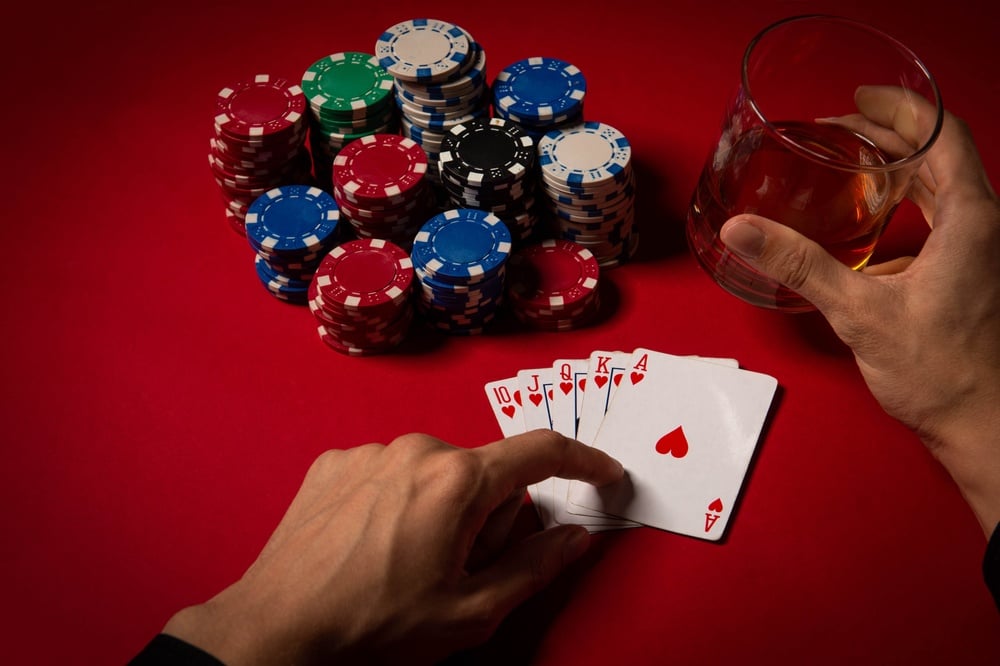
Image Credit: Vlasov Yevhenii/Shutterstock
The Benefits of Learning Heads Up Poker
There are just three major reasons why I would recommend playing heads up:
- People skills: Since you are only battling against one other person, you are more able to capture a ‘tell’ or get a read. (This includes playing online by the way — even when you cannot visually see your opponent, timing tells do exist.) Heads up poker can sharpen your ability to read another and maintain your own poker face.
- Creativity and bluff frequency: If you’re nervous about playing poker and the idea of bluffing makes your stomach drop, then heads up is a great way to practice. The lower likelihood of your opponent having a strong hand encourages you to play more creatively and make bold moves. Bluffing heads-up is less risky than in a full-ring game due to fewer players potentially holding strong hands.
- Tournaments: If you intend to play poker tournaments, you need to know how to play heads up. Tournaments play down to a winner —- when the field narrows to the final few players, you want to be comfortable playing in the bluffier, looser style in order to close the deal.
Taking Advantage of Heads Up Insecurities
Many local casinos have daily tournaments which will usually not play down to a winner. Instead, the players will propose a ‘chop’ — dividing the winnings proportionately by chip stack. For example, the person with the biggest stack will earn close to the first place payout.
Most players will favor a chop deal because they are afraid to play heads up. You can exploit this. They will likely not have experience or confidence in playing heads up poker. Just knowing the two basic strategic principles will give you a huge advantage:
- Play more hands: You are much more likely to have a good hand when faced with fewer opponents.
- Bluff more frequently: Your opponent is much less likely to have a hand good enough to call you with.
Lowering your threshold of what constitutes a good hand underlines all heads up strategy.
Also keep in mind that when someone proposes a chop, it’s not decided by a majority vote. Everyone at the final table could vote in favor of a chop except one person —- and the deal is off. It only takes one objection. Since so many people are insecure about playing heads up, you can use this to your advantage.
Win Without Actually Playing
I once found myself at the final table of a daily poker tournament at a local casino. With six players remaining, I was fourth in chips. The others suggested an ‘ICM’ chop, offering me a payout close to fourth place. I countered that I was happy to agree to a chop… if I was offered second-place prize money.
They laughed, then they screamed. They were furious — how could I propose such a thing? How could I be so audacious? Well, I knew that their eagerness to make a deal and resistance to playing heads up was something I could use to my advantage. A few minutes later, they reluctantly agreed.
Their fear of playing heads up and my confidence in the format allowed me to successfully drive a hard bargain, and secure a juicy second place prize.
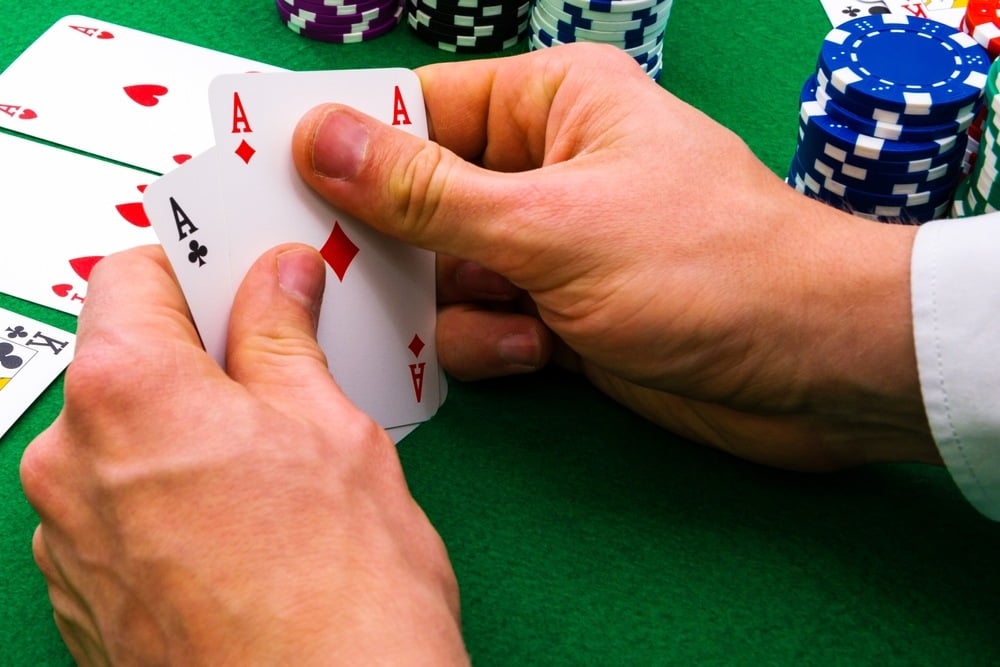
Image Credit: Blezzer/Shutterstock
Final Strategy Shift: The Math Changes
We now know that everything in heads up poker strategy is driven by the fact that it’s less likely you’re up against a strong hand. This means you should play more hands and bluff more frequently. Since your opponent will likely employ the same heads up poker strategy changes, you might want to call down their bets lighter.
You also need to be aware that the math shifts too.
When you play heads up, you want to avoid chasing too many draws like flushes or straights. The reason why is that your ‘pot odds’ are almost always going to be worse.
An Example of The Math Changing
Let’s say someone bets $10 and four people call. There is now $50 in the middle just from the flop round alone, and you are faced with a decision with a flush draw. Should you call the $10? Absolutely — you are calling $10 to win a pot of what will be over $60 (their $50 bets + your $10 + any preflop money). That’s a great price!
A flush draw will complete around 36% of the time — so you’re getting great odds to draw. (Read more on poker probabilities in my cheat sheets here or purchase my book A Girl’s Guide to Poker.)
Since more people participated in the hand, there’s more money in the middle. You are thereby more incentivized to ‘chase’ your big draw. Because if you win, you will 6x your money! That should entice you to take the 36% gamble!
But now let’s say you’re playing heads up, and your opponent has bet $10. You now have to call $10 to win a pot that so far totals maybe a little over $20 (their $10 + your $10 + preflop bets). A 2x return on your money isn’t as appealing as a 6x return now, is it? In this case, the 36% gamble doesn’t look as fun at all.
Instead focus on ‘made hands’ that are already completed rather than draws. Because, hey, as you now know, when you play heads up poker, even a pair can be pretty good.
]]>- A push in blackjack or online blackjack signifies a draw, when both the player and dealer have hands that hold the same total points.
- It can occur if both the player and dealer have a “blackjack” (Ace and 10-value card), or if they have equal total points from 17 to 21.
- If a push occurs, the player’s initial bet is returned and no money is won or lost.
- Push rules can differ among blackjack variations, casinos, and live dealer poker. Some casinos have a “dealer wins on push” rule, which is unfavorable to players.
- Understanding a push is vital due to its impact on blackjack odds and strategy. A push situation may influence how a player chooses to play certain hands.
If you’ve ever played blackjack, you have experienced a push (where you and the dealer end up with the same hand value and so your wager is returned to you). A push can feel disappointing, but it’s an important part of the game.
This article will provide all the details you need to know.
What Is A Push In Blackjack?
Different land-based and online casinos might vary rules at their blackjack tables, but the rules around a push are the same everywhere. It’s a tie, so your initial wager is returned to you.
Here’s a gameplay example of a common push in blackjack:
- You place a $20 blackjack bet.
- You receive two cards and the dealer’s hand is one face-down (or hole card) and the other face-up.
- You have 10-6, giving you a hand value of 16.
- The dealer’s up-card is a jack (valued at 10), so you hit (that is, take an extra card) and get a 2, giving you 18.
- You elect to stand.
- The dealer’s hole card is turned over; a 4. The dealer has 14 and must hit.
- The dealer gets a 2. With 16, the dealer must hit again.
- The dealer gets another 2 and stands by rule.
- You and the dealer both have 18, so it’s a push. Your initial $20 bet is returned to you.

In the above scenario, your hand resulted in a push. But remember, blackjack is between individual players and the dealer. Other players might have won or lost against the dealer’s 18.
Can Other Bets Push in Blackjack?
If a player is dealt a pair and opts to split (that is, double the wager and use each card as the starting point for a new hand) each hand is played and evaluated independently.
A player being dealt two 8s should almost always split. That means placing another equal sized wager on the table and playing out each hand. If one hand drew a 10 and the other drew an ace, the former would have pushed against a dealer 18 and the latter would have won.
Some players tip dealers by placing a small additional wager on the table. These gratuity bets share the fate of the main bet, win, lose, or push. On the other hand, side bets – increasingly popular in many casinos – either win (rarely) or lose (usually).
How To Act (with a) Natural
In blackjack, player and dealer hands are compared strictly according to their final total value, regardless of the makeup of the hand. However, the rules don’t treat all 21’s the same. Getting dealt an ace and a 10 card is known as a natural or the eponymous blackjack. Although they never face each other, natural 21’s have certain advantages over 21’s made from three or more cards.
If you’re dealt a natural and the dealer shows any card 2 through 9, you get immediately paid 3 to 2 on your initial wager (a payout rate known colloquially as time-and-a-half, a profit of $75 on a $50 wager).
Likewise, if the dealer has natural, all player hands other than a natural lose immediately. In neither case is dealer or player given a chance to hit, adding cards in hoped of drawing to 21 and pushing against the opponent’s natural. ?
Ace (hopefully not) In The Hole
With an up card of 10, the dealer uses a special mirror on the table to peek at the hole card in order to check and see if they have a natural. If the hole card is an ace, the dealer has a natural.
That card is revealed and the game is over. All player hands lose unless a player’s hand is also a natural, in which case it’s a very frustrating push.
The Unkindest Blackjack Push Of All
The chance of an ace in the hole is around 8% for the dealer. But when the dealer shows an ace, the chance of having a ten card (ten, jack, queen, or king) in the hole is around 31%.
With such a high probability of a dealer natural a special process kicks in. Before peeking, the dealer offers players holding a natural an immediate win. But there’s a catch: the payout is even money rather than time and a half.
Players declining the dealer’s offer must sweat out what comes next. The dealer peeks and if it’s not a 10 card, the hand is a winner and the player is paid off at 3 to 2. But should the dealer turn over a dreaded 10 card, it’s a natural versus natural push and the player’s perfect Blackjack hand has gone to waste.
Here’s a gameplay sequence example:
- You place a $50 Blackjack wager and are dealt ace/king. A natural!
- The dealer’s up card is an ace. Argh!
- Before peeking at the hole-card, the dealer offers you the option of taking an even money payout for a profit of $50, which you decline.
- The dealer peeks, sees it’s a queen.
- The dealer flips the queen to complete the natural. Instead of a $75 profit if the dealer had seen any other card in the mirror…instead of a $50 profit if the player had taken the even money payout…it’s a soul-crushing push.
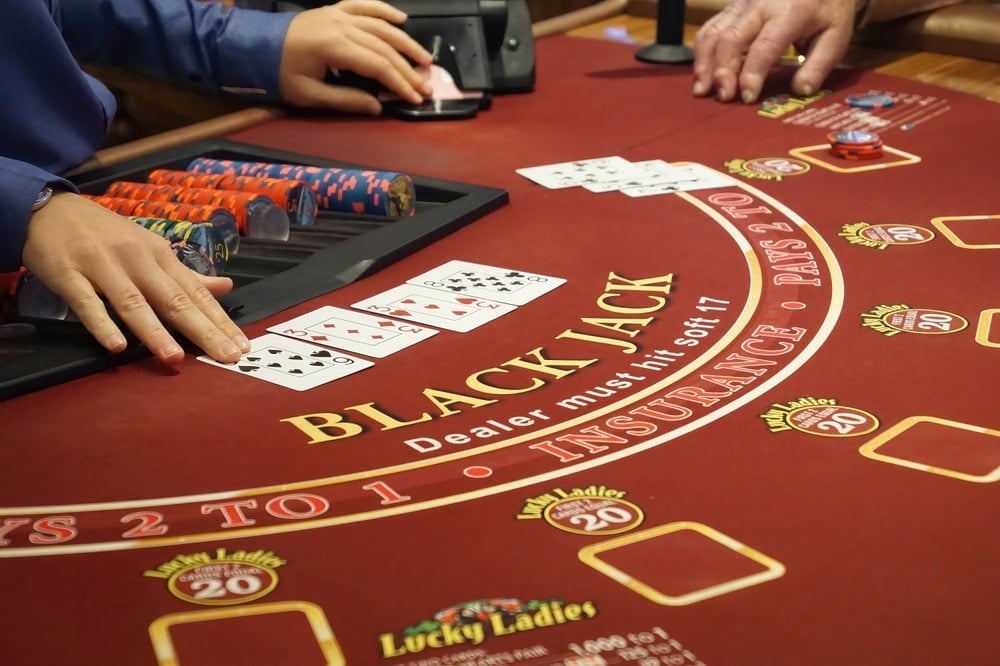
Image credit: Steve Estvanik/Shutterstock
Blackjack Push Probabilities
The probability of a push on any given hand is around 8.5% overall. Here’s the breakdown by specific hand:
- A dealer and player both getting a natural only happens once in every 429 hands, or a probability of 0.23%.
- Player and dealer both draw to 21: 2.3%
- Player and dealer both have 20: 2.5%
- Player and dealer both have 19: 1.5%
- Player and dealer both have 18: 0.7%
- Player and dealer both have 17: 0.5%
Those probabilities are approximate; the exact numbers depend on the specifics of the game. Here are factors that can affect the probability of a push:
- In general, fewer decks means a slightly higher push probability.
- Overall odds of a push increase slightly where the dealer hits on soft 17.
- Player tendencies and adherence to basic strategy can change the chance of pushes occurring. For example, players who hit (rather than stand) on soft 17 and or stand (rather than hit) on 12 versus a dealer’s Deuce will push slightly less often.
A Blackjack push is a good news/band news situation. Your hand, which may have been anywhere from decent to very good, didn’t win. But be thankful it didn’t lose either.
Hopefully you’re now better prepared to face a Blackjack push, and on your way to being a better player.
]]>- GTO Poker (Game Theory Optimal) and Exploitative Poker are two prominent strategies employed by professionals in both live and online poker. Both have distinct advantages depending on the situations and opponents.
- GTO Poker leverages mathematical models and game theory to make optimal decisions in every situation. It aims to create strategies that are unexploitable even by skilled opponents.
- Exploitative Poker, on the other hand, focuses on taking advantage of the opponents’ weaknesses and tendencies. It relies heavily on observing patterns in opponents’ play and then tailoring your strategy accordingly.
- The choice between the two often depends on the player’s skills, understanding of the game, and most importantly, the playing style of their opponents. A balanced approach can often be most beneficial.
- Ultimately, neither strategy is inherently “better”, but understanding and being able to implement both can give a player a substantial edge in diverse poker scenarios.
When thinking about the best approach to winning poker, there seems to be a lot of confusion about what Game Theory Optimal (GTO) in poker is, and whether it’s a better option than exploitative play in poker.
In reality, you don’t need to choose one of these options, but rather understand the basic principles of GTO play and when it should be applied.
In this article, I’ll try to go over every important detail to clear up any confusion, and I’ll start by explaining what GTO is and how it works in real-life scenarios.
What is GTO Poker?
Let’s start with the basics: What is GTO poker?
Game Theory Optimal (GTO) is basically when you attempt to play mathematically perfect poker, so that your opponents make mistakes against you. This strategy balances your value hands and poker bluffs in a way that leaves you unexploitable.
Since the phrase has the word ‘optimal’ in it, people often think that GTO in poker is a perfect approach that is better than anything else out there. But that’s not always true.
First of all, the GTO poker model revolves around the style of play that makes you unexploitable.
It means that if you were playing a true Game Theory Optimal, your opponents couldn’t find any way to take advantage of your style. No matter what they do. At best, they could break even.
On the flip side, though, the GTO poker approach is fairly rigid as it doesn’t allow for any adjustments. You’ll be following the same strategy against all opponents no matter what they do. So, while you can’t be exploited, you won’t be exploiting others, either.
GTO is often used in poker played in online casinos, because games like live dealer poker or video poker makes it harder to read your opponents.
The best way to explain this is through a simple example. If the GTO poker model dictates that perfect 3-bet size in a certain scenario is 13 big blinds, you’ll be 3-betting to that size regardless of who your opponent is.
Even if you’re up against a loose maniac who’ll gladly call a 30 big blind 3-bet when you have pocket Aces, you’ll not deviate from your standard strategy, and leave money at the table against that particular player.
So, clearly, there are some upsides and downsides to this approach, but before jumping into the details, I want to address another topic.
No-Limit Hold’em Hasn’t Been Solved Yet
If you hear the word ‘optimal’, you immediately think of something perfect. However, there is still no such thing as a perfect poker strategy. No-Limit Hold’em is a game with many variables, and is yet to be solved, especially in non-heads up games.
Besides, even if there were a complete solution to NLHE, it would be way too complex to memorize for a normal human being. There is absolutely no way you could learn by heart what to do in every single situation.
If you had that kind of memory, you could probably earn much more money doing something else instead of playing poker.
So, GTO is very useful for learning basic principles and understanding why certain plays make sense. It’s good for building a solid strategy that you can implement against tough opponents.
But it’s not necessarily the best way to play poker in every possible scenario.
The Main Issues With GTO in Poker

The biggest problem that comes to mind when talking about GTO poker is actually learning it.
If you want to adopt this style of play, you’ll have to spend many hours analyzing different situations, working with solvers, reading strategy books and watching training videos.
But you won’t be able to remember all of that information and play a GTO strategy all the time.
However, this doesn’t mean that you shouldn’t study a mathematical-based approach. It can help you learn a fundamentally sound strategy for almost all scenarios, and is the perfect starting point against any competition.
That being said, GTO in poker isn’t always the most profitable one because it doesn’t take into account players’ stats, tendencies, or reads in live games.
For example, if you’re up against a very loose player who opens many hands preflop or makes huge c-bets on flops every time, playing GTO in poker won’t make much money against this particular opponent. You need to adjust to their style and take advantage of their mistakes.
Of course, you’d still be winning by sticking to GTO in this scenario, just not as much as you could.
Exploitative Play in Poker: Reading Into People’s Tendencies
The exploitative play in live poker has been around for much longer. In fact, some of the best in the game had used this style to win heaps of money over the years, long before the idea of GTO poker took hold.
It’s important to understand that exploitative play still means you have to play very strategically sound and solid poker. You still have to make good hand selection before the flop, be mindful of your position, and pay attention to pot odds.
But then you go one step beyond.
This is a style of play where you open yourself to being exploited but make more money by targeting your opponent’s mistakes instead of balancing your ranges.
Many weaker players are unable to readjust to these changes, so playing a GTO style against such an opponent would mean leaving money on the table.
Example of Poker Exploitative Play
Let’s look at an extreme example.
You sit down at a 2/5 table, and you don’t know any of the players, but you saw that one guy open-shoved five times in a row. Two times he got looked up and showed ATo and T9s. You can now be pretty certain this player is here to gamble.
This is where GTO considerations go out of the window, and you snap them off with pocket tens, AQo, or even weaker holdings. Their showing range is just so wide that it makes no sense to stick to GTO and keep folding as if they were playing normal ranges.
The same applies to a completely contrasting scenario.
If you’re up against an ultimate nit who never bets big without the nuts, you can safely fold even some of your strongest hands when facing such bets on the river from this particular opponent.
While this would open you up to being exploited by competent players, it’s fine to do against someone who pretty much has just one gear.
Of course, situations are rarely this clear cut in real life.
Sometimes, you can make bad assumptions or misread the situation and only hurt yourself trying to adopt exploitative play.
So when you’re not sure how to exploit your opponents, GTO play is your best option.
Are Poker GTO And Exploitative Poker Mutually Exclusive?
There also seems to be some confusion among players about having to choose either one or the other style and stick to it, which is completely false.
As already mentioned, learning GTO basics is vital for learning solid poker strategy foundations.
After all, if you’re going to vary your styles and exploit your opponents, you need to understand where they’re making mistakes, which you can’t do without knowing the right strategy yourself.
Learning GTO (at least to some extent) is also very useful for situations where you find yourself at tough tables or against unknown players. For example, you could be seated at a tough table in a poker tournament with players that are better than you.
Here, resorting to GTO might be your best option as an exploitative poker strategy would probably hurt your chances of winning.
So, these two concepts are not mutually exclusive, and, ideally, you’ll want to learn both.
This will make you a much tougher opponent overall as you’ll be prepared to tackle different scenarios and able to adjust to new situations at the tables. Once again, you don’t need to try and learn the entire GTO by heart.
It would be an overkill and pretty much impossible to do. What you want to do instead is analyze some frequent scenarios to understand the balanced play in these spots.
This should give you a pretty accurate idea of what to do in similar situations to keep your ranges balanced and your play close to GTO.
More On Exploitative Poker Play: Adjusting & Readjusting

Like game theory optimal strategy the exploitative approach has its drawbacks, too.
While GTO has its foundations hardcore math, poker exploitative play is more about guessing your opponent’s tendencies. As you probably know, conclusions made at a poker table aren’t always perfect or even correct at all.
Earlier in this article, I gave an extreme example where switching to an exploitative approach would be +EV.
But, in real life, things usually aren’t as simple. You’ll have to make much thinner reads and find smaller leaks in players’ styles that you can use to your advantage. A problem with making these adjustments is that you often don’t have enough information.
Seeing someone play a few dozen hands can give you some idea about their tendencies and inclinations in particular spots, but you shouldn’t overvalue that type of info.
With a small sample size, it could still just be a coincidence.
For example, you could see a player 3-bet several hands in a short span. Your initial thought might be that they’re probably doing it with a wide range of hands and that you might adjust to it by opening fewer hands or starting to 4-bet them as a bluff.
However, it’s entirely possible that they’re just running hot and have been dealt with some really good hands in a short time span.
While the exploitative style can definitely be more profitable, you need to make sure the information you’re basing your adjustments on is solid. Don’t be too quick to draw conclusions.
Be Mindful Of Other Players During Exploitative Poker
Another drawback of the poker exploitative play is that it opens doors for you to be exploited.
For example, you could adjust to a loose opponent who opens many hands preflop by 3-betting them light in position.
Against that particular player, your play is perfectly reasonable and will result in profit in the long run. However, you can face some problems if you’re not playing heads up. If there are some other competent players at the table, they might take notice of what you’re doing.
If a good player realizes you’re isolating a weak opponent too often, they might come after you. Since you’re 3-betting light, you won’t be able to do much when they start 4-betting you.
So, when making your adjustments, it’s not just the player you’re targeting that you need to consider. You also have to think about others involved in the game and what they might do.
If you notice one or two of them are starting to change their style to attack your adjustments, you’ll need to recalibrate your strategy.
You don’t have to deal with any of this when using GTO, which is why this approach is so powerful. You just know what you’re going to do and don’t care about what others are doing.
Always Mix Things Up
So, to wrap this discussion up, will you be better off playing GTO or an exploitative poker strategy?
The answer is… both!
Neither is better. Each serves a different purpose and depends on what kind of games you play.
In tough lineups, the GTO approach will usually work better as you’ll leave very little room for your opponents to take advantage of your plays.
In weaker games where your opponents aren’t paying as much attention and aren’t adjusting to your changes, you’ll make more money playing an exploitative poker strategy.
Since most of the time you’ll find yourself in situations with both weak and strong players at the table, you’ll be best off knowing both strategies.
That way, you can vary your style as needed and play exploitative strategy against weaker players to take full advantage of your mistakes and adopt the GTO approach against strong opponents to make sure they never get the upper hand.
]]>- ICM, or Independent Chip Model, is a mathematical model used in poker to calculate a player’s overall equity in a tournament.
- The model is essential in tournament play, especially during final table and bubble play, where it helps calculate the real monetary value of a player’s chip stack.
- ICM considers factors such as the total chips in play, the payout structure, and the player’s current chip stack to calculate the expected payout or equity.
- Understanding and utilizing the ICM can greatly influence strategies, particularly when deciding whether to risk one’s tournament life.
- While ICM is a valuable tool in decision-making, it also has limitations and doesn’t account for variables such as player skill levels and blinds. Use it as part of a broader strategic framework.
If you play poker tournaments, either online or at your local casino, it’s crucial to understand poker ICM, or the Independent Chip Model. While it might sound like technical jargon, knowing ICM poker strategies – and what does ICM mean for your poker strategy – is incredibly valuable.
Let me explain.
How is The Independent Chip Model Used in Poker Tournaments?
The first thing you need to know about ICM poker is that it only applies to tournaments and online poker tournaments. Not cash games.
When you’re playing poker, you want to ask yourself what is the best decision mathematically. Am I getting a good price to complete my flush draw? Straight draw? Gutshot? Do I think I likely have the best poker hand? When you’re playing a poker tournament, however, you want to ask yourself two questions:
- What is the best mathematical decision I can make?
- How will this decision impact my position in the tournament?
It’s the second question that changes everything – and gets to the heart of ICM poker model.
For example, let’s say you’re getting excellent pot odds to draw for a flush. The math tells you to call, even if it’s for your entire stack. In a cash game, you should always take this opportunity because you can profitably win money; if you miss your flush draw, you can easily rebuy.
Now let’s say you’re a big stack in a poker tournament or online poker tournament and there are only five people left. According to the ICM model in poker, you would not want to take this opportunity because it would jeopardize your position.
The chips you would lose are worth more than the chips you would gain. Said another way, the benefit of going from second or third in chips to first in chips is not worth the risk of elimination.
What is ICM in Poker?
ICM means adjusting your decision-making to your ranking in the tournament rather than the value of your hand.
Here’s another crazy example.
- Imagine there are three people left in an online casino poker tournament.
- You’re tied for the chip-lead. The person in third place is very short-stacked.
- Your fellow big stack goes all-in — and you look down at a shiny pair of pocket jacks.
What do you do here?
- In a normal three-player cash game, you would almost always call. It’s highly unlikely your opponent has a better hand than you, especially with so few players.
- But in a poker tournament where you need to factor in poker ICM, you should fold.
Why? Because even if you have a better hand than your opponent, it’s not worth the risk. Perhaps they have Ace-Ten, where you’re a nearly 70% favorite. Or a pair of threes, where your equity is closer to 80 percent. Doesn’t matter. The 20-30% of the time that they will outdraw you poses too great a threat to your chip stack.

Image Credit: Kitreel/Shutterstock
A Real Life Example of Extreme ICM
I once put someone to the ultimate poker ICM test. I was at the final two tables of a $350 tournament, fewer than 20 people remained. First prize was over $30,000. I was second place in chips.
Only one person had more chips than me — had me ‘covered’ — and he raised preflop. I called with a pair of nines. The player in the big blind was a short-stack and went-all in. The then chip-leader called.
I decided to go all-in to isolate the short-stack, figuring my pair of nines could likely beat one player but would struggle against two.
The chip leader was outraged, visibly distressed, and asked for an exact count of my stack. We were incredibly close. After someone called ‘time’ on him, he finally called… with pocket aces.
Why the hesitation? With a pair of aces?! Because of ICM. Even though he was an 80% favorite against almost any hand I had, it was still an enormous risk. Eighty percent of the time, he would win the pot and increase his chip lead. But 20% of the time, he would finish with just over a min-cash and a meager profit margin.
Mathematically, he should always call. But ICM poker made him think twice.
Strategies For Utilizing Poker ICM
Short stack IMC poker strategy
Since you don’t have much to lose, you can play more freely and aggressively. When you’re low on chips, ICM poker doesn’t really apply since there is no ‘expected payout value’ to deserve.
Medium stack IMC poker strategy
you need to keep an eye on stack sizes at all times. If you’re at a final table and in the middle of the pack, it would be a disaster to get eliminated before a short stack. You have to play much tighter in hopes that a smaller stack will bust — earning you a higher payout.
Big stack IMC poker strategy
big stacks can apply great pressure on middle stacks according to ICM poker. The middle stacks still have a lot to lose so you can ‘bully’ them by presenting tough decisions. A middle stack might fold a strong poker hand, such as as pocket queens if a micro short stack is about to bust.
So as a big stack, you can shove wide. Just be cautious when it comes to tangling with other big stacks — you want to tread those waters carefully and generally avoid.
What is the Major Drawback of ICM Poker Analysis?
As you can see from my real life example, an ICM poker analysis made what would usually be a slam-dunk easy decision a close call. It changes the math.
In detailed ICM analysis, a computer calculates your decision — factoring in payout considerations. Advanced programs can, in fact, adjust your decision based on your current ranking. Truly adhering to ICM means following the math adjusted for your tournament standing, but in everyday play, it involves prioritizing the potential for larger pay jumps over the immediate strength of your hand.
The ICM poker model generally encourages more conservative play, focusing on avoiding short-term swings to achieve bigger payouts.
However, the granular Independent Chip Model approach is unrealistic for most players. Humans can’t process these decisions quickly (it’s hard enough to learn basic poker probabilities). Calculating whether you should call an all-in with Ace-King based on your tournament position is nearly impossible for most people. In practice, you might fold Ace-King due to ‘ICM pressure,’ aiming to avoid variance and maintain your chip lead.
ICM Poker Doesn’t Take Into Account the Human Factor
Another drawback of strict ICM analysis is that it doesn’t account for the human factor. Some players are tighter and bluff less than a computer might assume. (Computers tend to overestimate bluff frequencies.)
Your decision to call or fold will also depend on your ‘reads’ and ability to spot tells. Someone born before 1945 might jam a smaller percentage of hands than a younger player, but computers don’t incorporate a senior citizen discount.
Customizing ranges in computer applications called ‘solvers’ can help, but emulating this on the fly is extremely impractical and overall unnecessary.
As long as you weigh your standing in the tournament against your actual hand, you are already taking Independent Chip Model poker into consideration.
ICM Poker Demystified: Elevating Your Game With Strategic Insights
Understanding what is ICM in poker tournaments can increase your chances of winning by reducing risks. It involves adjusting your decisions based on your poker tournament position rather than just the value of your hand.
While mastering ICM Poker can lead to better choices — you can even study and memorize computer outputs — it’s also important to balance the math with the practical realities of live play and human decision-making.
Title image Credit: Kitreel/Shutterstock
]]>